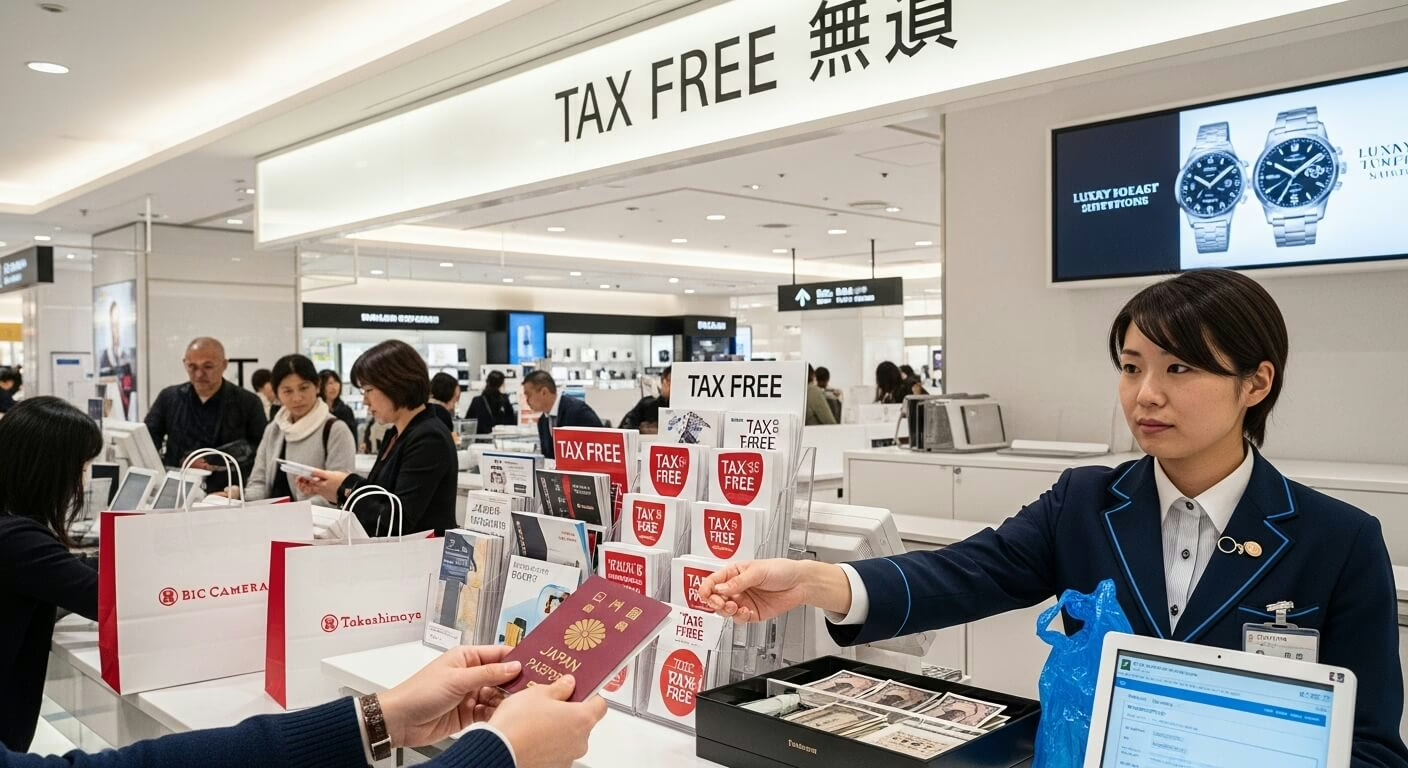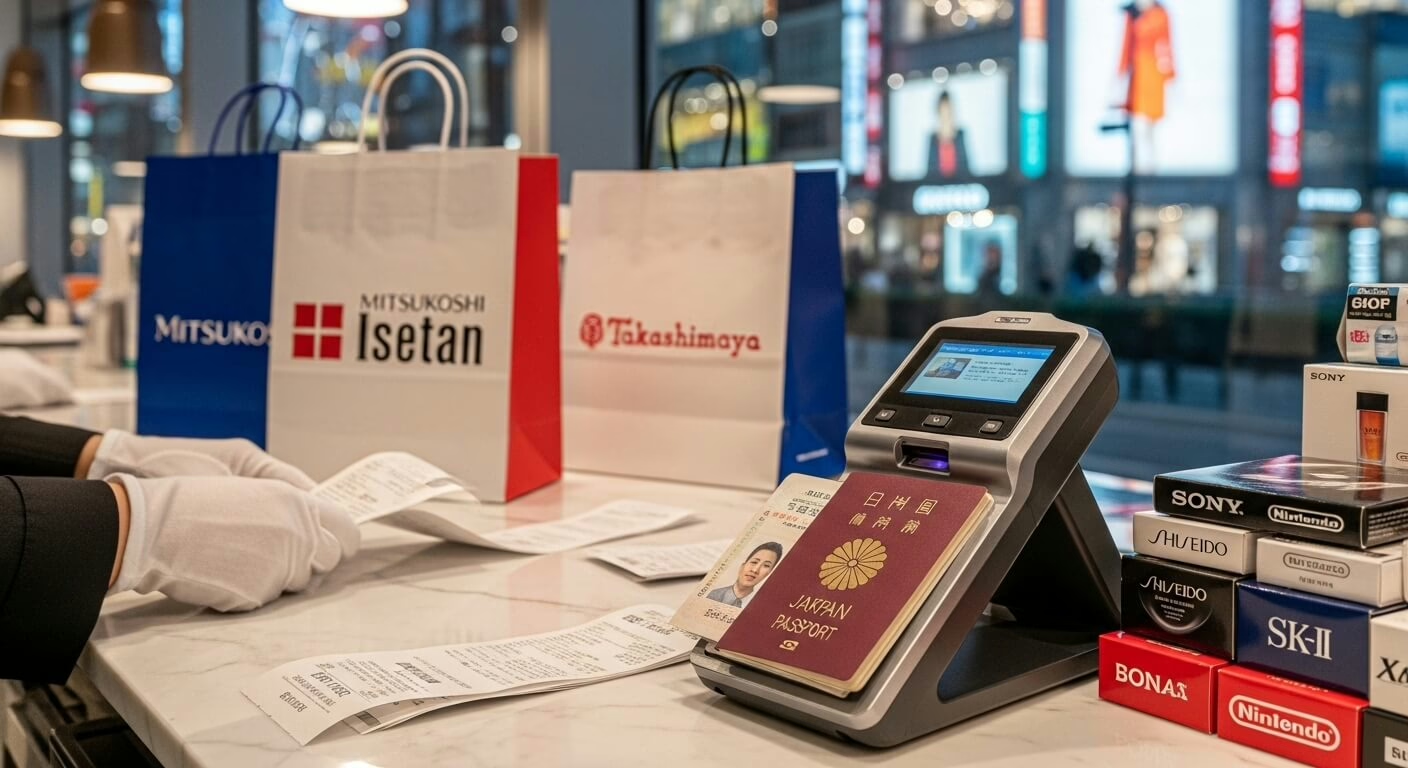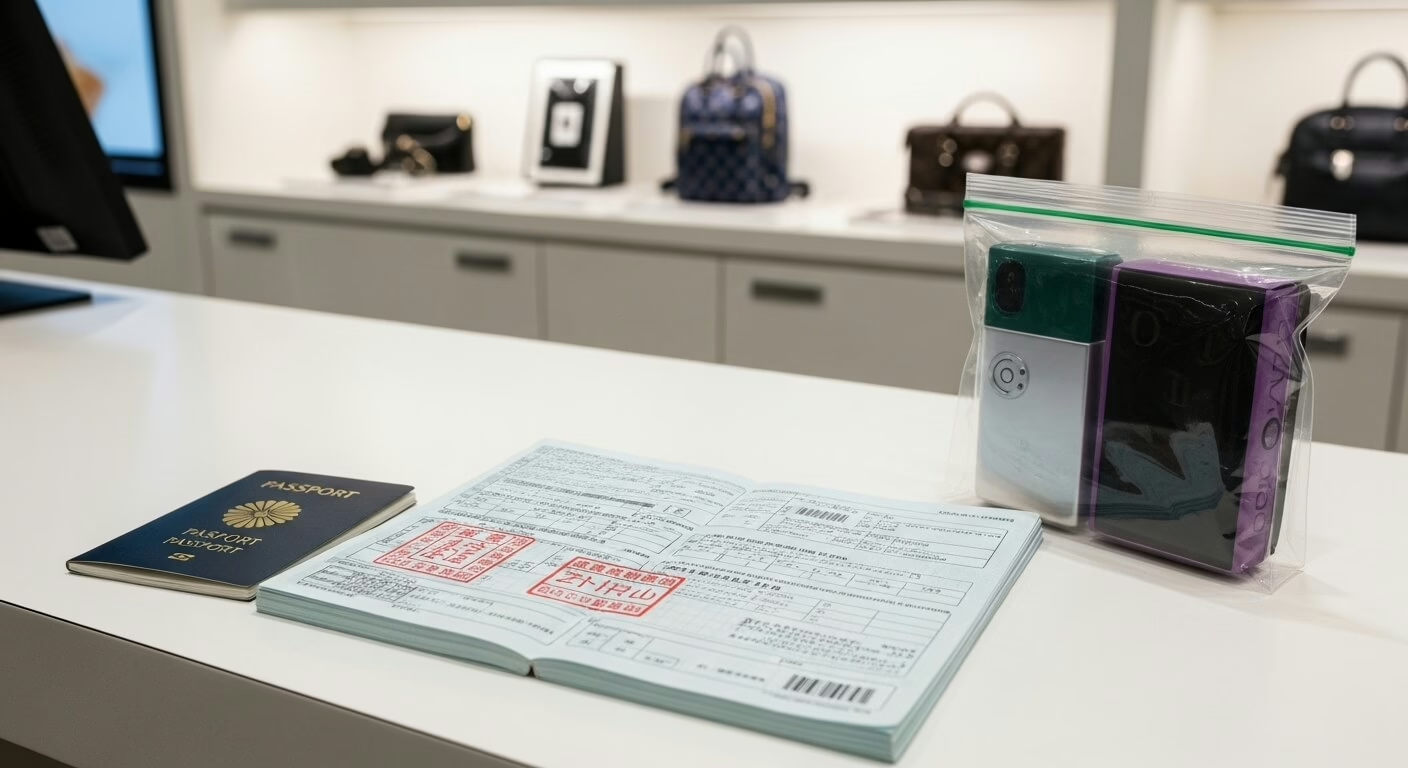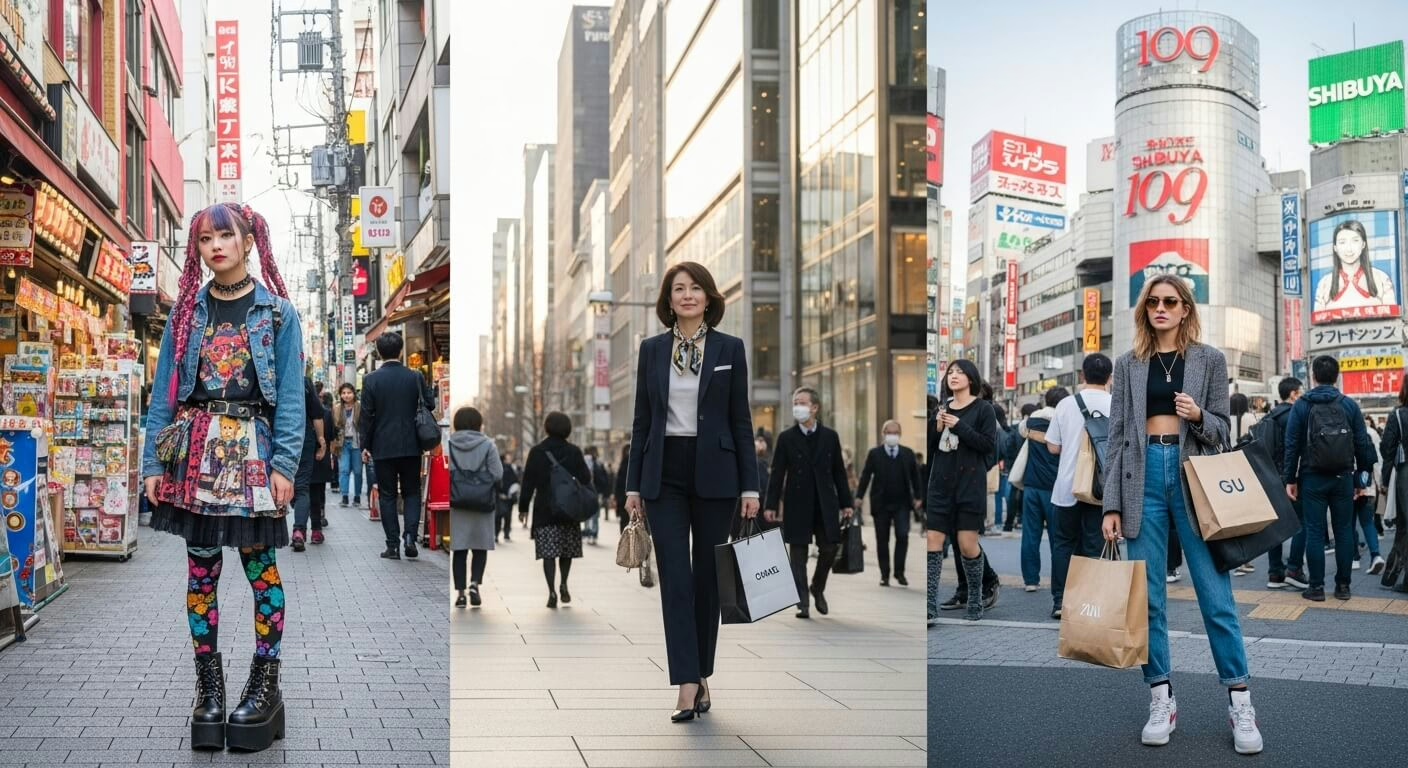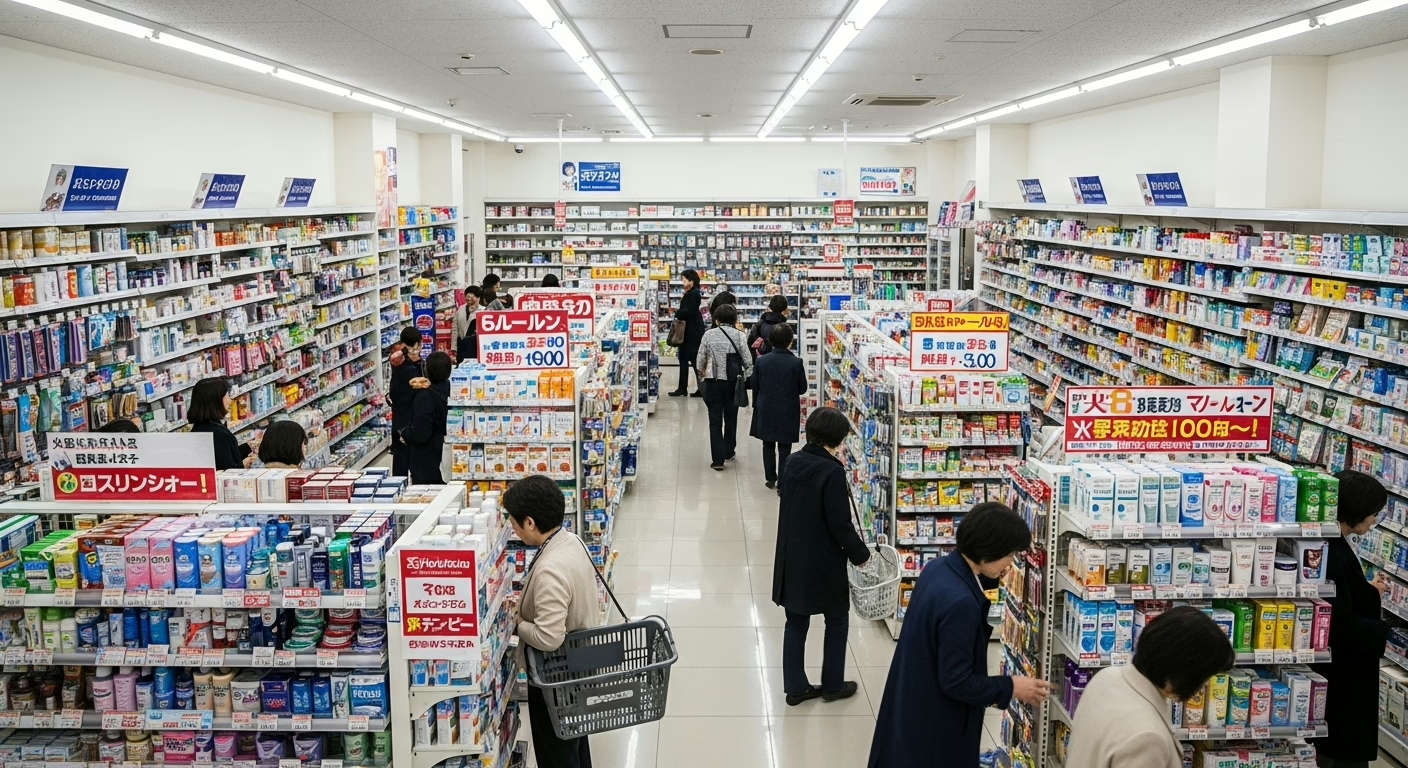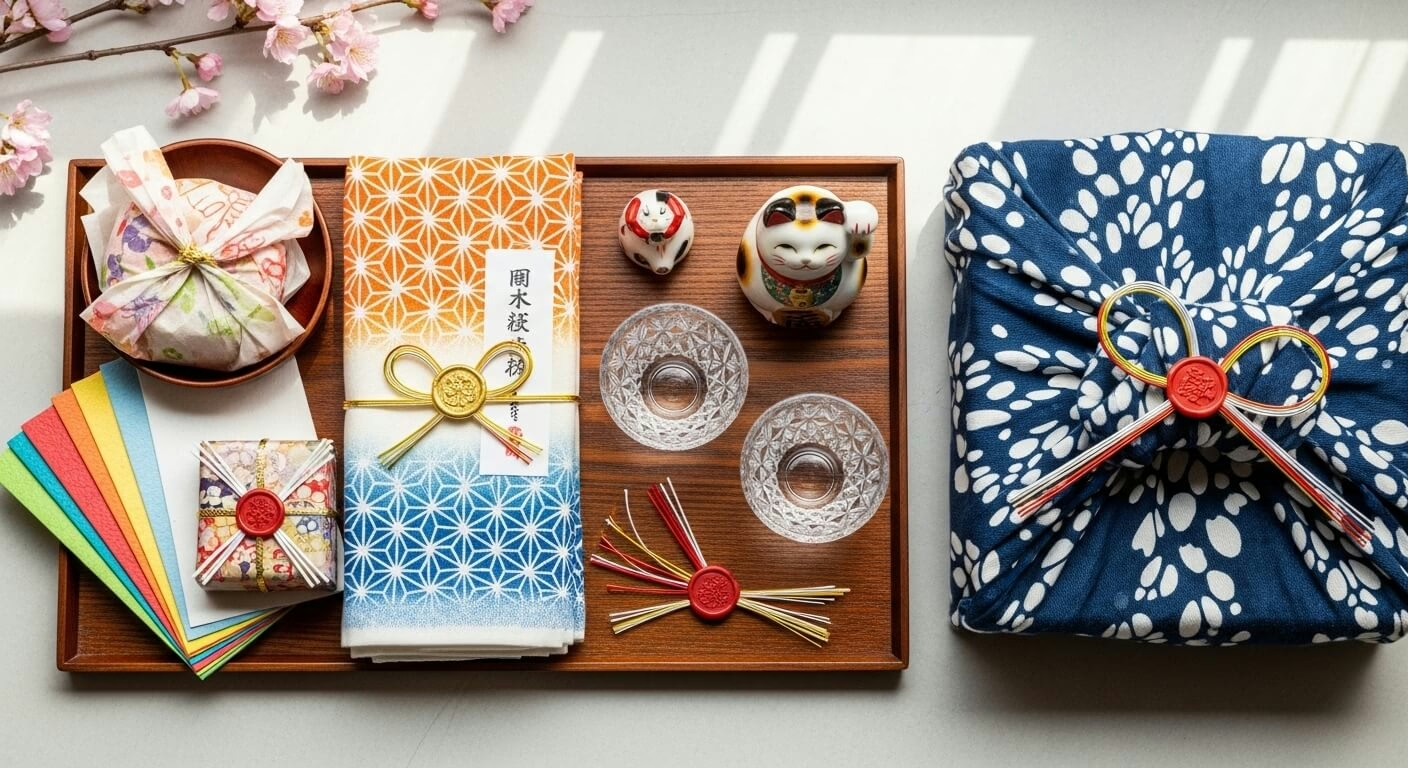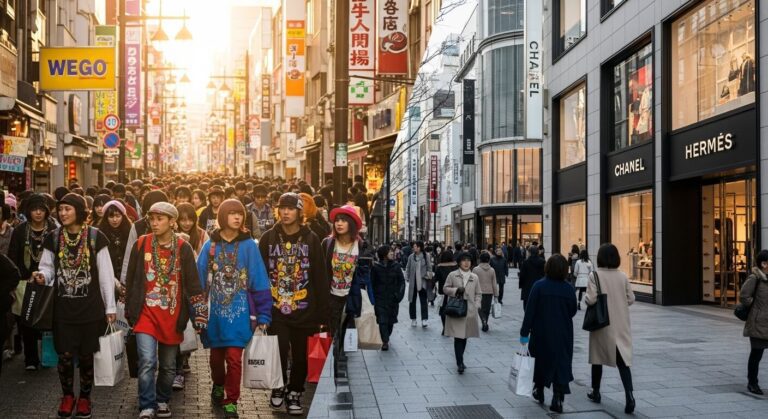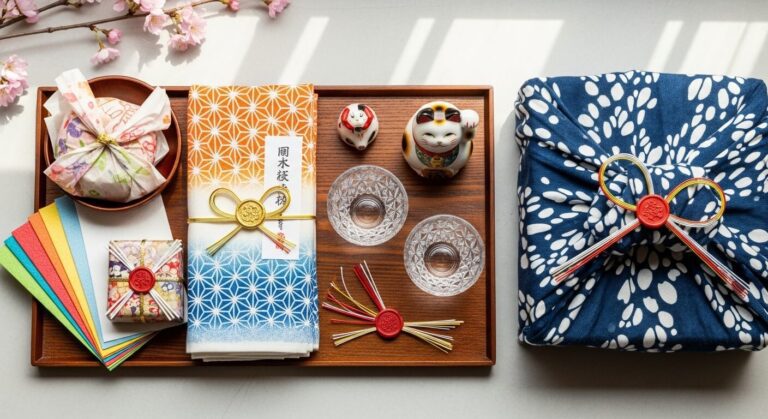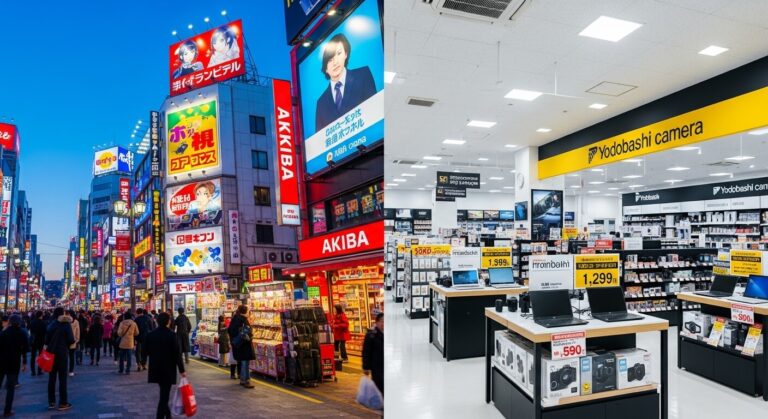Tokyo Duty-Free Shopping: Best Stores & Tax Refund Process
Complete Tokyo Tax-Free Shopping Guide: Refunds and Top Stores – Tokyo’s tax-free shopping system instantly refunds Japan’s 10% consumption tax on purchases over ¥5,000 at checkout—just present your passport at major department stores like Takashimaya and Isetan, electronics giants like Yodobashi Camera and Bic Camera, or luxury boutiques in Ginza and Omotesando.
The process takes about three minutes as staff staple a Purchase Record Form into your passport, which customs collects when you depart Japan.
This guide covers everything from navigating tax-free counters to maximizing savings across Tokyo’s best shopping districts.
Key Highlights
Hide- Major duty-free stores include Mitsukoshi, Takashimaya, Isetan, Bic Camera, and Yodobashi Camera, all with dedicated multilingual tax-free counters.
- Tourists with 90-day visas qualify for 10% tax refunds on purchases over ¥5,000 per category per store per day.
- Present your original passport at checkout; staff provide a signed Purchase Record Form stapled into your passport with receipts.
- Tax refunds are instant and applied immediately at checkout, with the entire process taking approximately three minutes.
- Customs officials verify stapled documents and exported goods during airport departure; keep forms attached until then.
Tokyo Duty-Free Shopping Guide: Tax Refunds, Best Stores, and Money-Saving Strategies
Shopping in Tokyo becomes considerably more rewarding when travelers understand the city’s duty-free system, which offers substantial savings on everything from high-tech gadgets to traditional crafts.
Tokyo Trip Add-Ons
Equip yourself for the ultimate Tokyo adventure with the following add-ons, curated just for you.
Major department stores like Mitsukoshi and Takashimaya feature dedicated tax-free counters where international visitors can score discounts on luxury brands without the hassle of airport claims.
The process is invigoratingly straightforward—just present your passport at checkout, and voila, instant savings!
Smart shoppers combine duty-free privileges with strategic souvenir shopping at electronics meccas like Bic Camera and Yodobashi, where you’ll find cameras, cosmetics, and quirky Japanese innovations at already competitive prices.
Don’t overlook neighborhood shops in Asakusa and Harajuku, which increasingly offer tax exemptions on traditional items like kimono accessories and artisan ceramics, making authentic cultural treasures surprisingly affordable.
How Japan’s Tax-Free System Actually Works
Japan’s consumption tax system might seem confusing at first, but here’s the deal: that 10% tax tacked onto nearly everything you buy can actually go right back into your pocket if you know the rules.
Not every visitor qualifies for these sweet refunds—you’ll need to meet specific tourist requirements and carry the right documentation to prove you’re just passing through.
The system also operates on minimum purchase amounts that vary depending on whether you’re buying consumables like snacks and cosmetics or general goods like electronics and clothing, so understanding these thresholds before you shop will maximize your savings.
Consumption Tax Basics: That 10% You Can Get Back
Every purchase a traveler makes in Tokyo includes a national consumption tax of 10%—and yes, that percentage adds up fast when you’re buying electronics, cosmetics, or luxury goods!
This standard rate applies across the board, from high-end luxury brands in Ginza to quirky souvenir shops in Asakusa.
The beauty?
Foreign visitors can reclaim this entire amount through Japan’s tax-free system.
Here’s what qualifies for that sweet 10% refund:
- General goods like electronics, watches, bags, and clothing (minimum ¥5,000 purchase)
- Consumables including cosmetics, food, and beverages (minimum ¥5,000, maximum ¥500,000)
- Combined purchases from the same store on the same day that meet threshold requirements
Understanding these categories means maximizing your savings potential!
Tourist Eligibility Requirements: Who Qualifies for Refunds
The tax-free shopping privilege isn’t a free-for-all—Japan has specific criteria that travelers must meet to access those refunds.
First up, you need a short-term tourist visa, typically that stamped entry allowing 90 days or less.
Sorry, foreign residents with work visas don’t qualify, even if you’re dreaming of luxury brands on discount!
Retailers require your passport at checkout to verify your status and process the paperwork.
The minimum purchase threshold matters too: generally ¥5,000 (about $35) in consumables or general goods per store, per day.
Whether you’re grabbing designer goodies or souvenir shopping for friends back home, that amount accumulates quickly.
Most major department stores and dedicated tax-free shops streamline the verification process, making your freedom to shop internationally both rewarding and surprisingly straightforward.
Minimum Purchase Thresholds: Spending Rules by Category
Japan’s tax-free shopping system splits purchases into two distinct categories—general goods (like electronics, clothes, and accessories) and consumables (food, drinks, cosmetics, and medicine)—each with its own ¥5,000 minimum spending threshold that must be met in a single store on the same day.
Here’s the brilliant part: if you’re buying from both categories at a participating retailer, you can hit each minimum separately and walk away with tax exemptions on everything!
Understanding these category divisions transforms a casual shopping trip into a strategic mission where knowing what counts as “consumable” versus “general” can save you serious yen.
General Goods vs. Consumables: Different Limits Apply
Understanding tax-free shopping categories in Tokyo requires grasping one crucial distinction: consumable items and general goods operate under completely different spending thresholds, and mixing them up can mean missing out on tax savings!
Key differences include:
- General goods (duty free electronics, clothing, accessories) require ¥5,000+ purchases.
- Consumables (food, cosmetics, beverages) need ¥5,000-¥500,000 spent.
- Consumables restrictions mandate sealed packaging—you can’t open them in Japan!
Combining Purchases: When You Can Bundle Items
While many shoppers assume each purchase must individually meet the ¥5,000 minimum, here’s the wonderful truth—you can absolutely bundle multiple items from the same category together at a single store to reach that magic threshold!
This merchandise bundling freedom transforms your shopping experience, letting you mix-and-match clothing, accessories, or electronics seamlessly.
Remember though, store specific policies vary slightly, so always confirm bundling rules at checkout before celebrating your tax-free victory!
Documents You Need for Tax-Free Shopping
Getting tax-free status on your Tokyo shopping spree isn’t as simple as flashing any old ID—you’ll need specific documentation at every transaction, and trust me, the cashiers check everything carefully!
Your original passport serves as the cornerstone of the entire process, working alongside temporary visitor stamps and specially signed tax-free forms that create an official paper trail.
Passport Requirements: Original Only, No Copies Accepted
One of the most critical rules when shopping duty-free in Tokyo is that stores will only accept your original passport—photocopies, smartphone photos, or digital versions simply won’t cut it.
This non-negotiable requirement exists because retailers must complete proper passport validation and submit accurate customs declarations to Japanese tax authorities.
Here’s what you absolutely need to know:
- Always carry your physical passport when planning tax-free shopping excursions around Tokyo’s retail districts.
- Hotel safes are your enemy on shopping days—leaving your passport locked away means missing out on those sweet tax savings.
- Damaged or expired passports may be rejected, so double-check your document’s condition before heading out.
Think of your passport as your golden ticket to significant savings throughout Tokyo’s incredible shopping landscape!
Temporary Visitor Status: Visa Rules and Entry Stamps
Having that original passport in hand won’t do shoppers much good unless it contains the right visa status and entry documentation.
Here’s the deal: tourists need that coveted “Temporary Visitor” stamp in their passport to *access* tax-free shopping privileges!
Most travelers from visa-exempt countries automatically receive this designation upon arrival, marked clearly in those all-important visa stamps.
Immigration officers typically grant 90-day temporary visitor status—perfect for extended shopping adventures.
However, entry restrictions apply to certain visa types.
Students, workers, and long-term residents can’t *obtain* duty-free benefits, regardless of how recently they arrived.
Check those visa stamps carefully before heading to the stores, because merchants will absolutely verify this status.
Without proper temporary visitor documentation, shoppers face full retail prices plus Japan’s standard consumption tax!
Tax-Free Forms: What You’ll Sign at Each Store
What exactly will shoppers sign when claiming those tax-free savings at checkout?
The process involves straightforward paperwork that won’t bog you down!
Here’s what you’ll encounter:
- Purchase Record Form – This official document lists all your tax-free items, verifying you’re a temporary visitor.
- Passport Attachment – Staff perform receipt stapling directly into your passport, creating an unbreakable paper trail.
- Declaration of Export – You’ll pledge to carry these goods out of Japan within six months.
The whole signing process takes maybe three minutes, and you’ll notice the refund timing is instant—your discount applies immediately at checkout rather than requiring later reimbursement!
Keep those stapled receipts pristine until customs inspects them at the airport, where officials will remove them upon your departure.
Record of Purchase: Documents Stapled in Your Passport
Those signed forms from the previous section become permanent passengers in your passport—literally!
Store staff will carefully staple the tax-free purchase record directly into your passport, creating a paper trail that customs officials will check when you depart Japan.
This passport stapling process might seem archaic in our digital age, but it’s the government’s foolproof method for tracking duty-free purchases.
Alongside the official forms, clerks often attach itemized receipts through receipt stapling, giving you a complete purchase history bound right there in your travel document.
Don’t worry about your passport getting bulky—customs officers will remove these stapled documents when you exit the country, freeing your passport from its temporary paper companions and completing your tax-free shopping adventure!
Best Department Stores for Duty-Free Shopping
Tokyo’s premier department stores have transformed tax-free shopping into an art form, combining world-class merchandise with streamlined refund services that make grabbing those duty-free deals almost effortless.
The city’s retail giants—from Shinjuku‘s fashion powerhouses to Ginza‘s elegant establishments—each bring their own specialty to the table, whether that’s luxury brand collections, lightning-fast processing, or English-speaking staff who actually understand what tourists need.
- Tokyo Department Store Tax-Free Shopping Made Simple
- Tokyo Happy Hour Guide: Best Drink Deals by Neighborhood
- Tokyo Public Transportation Day Pass: Maximum Value Guide
- Tokyo Budget Guide: ¥5,000 Daily Breakdown & Tips
- Tokyo Discount Coupon Guide: Where to Find Tourist Savings
- Tokyo With Kids: Family-Friendly Activities & Tips
Knowing which department store matches your shopping style can save you serious time and maximize those tax refunds while you hunt for everything from designer handbags to Japanese cosmetics.
Takashimaya Shinjuku: Luxury Brands and Tourist Services
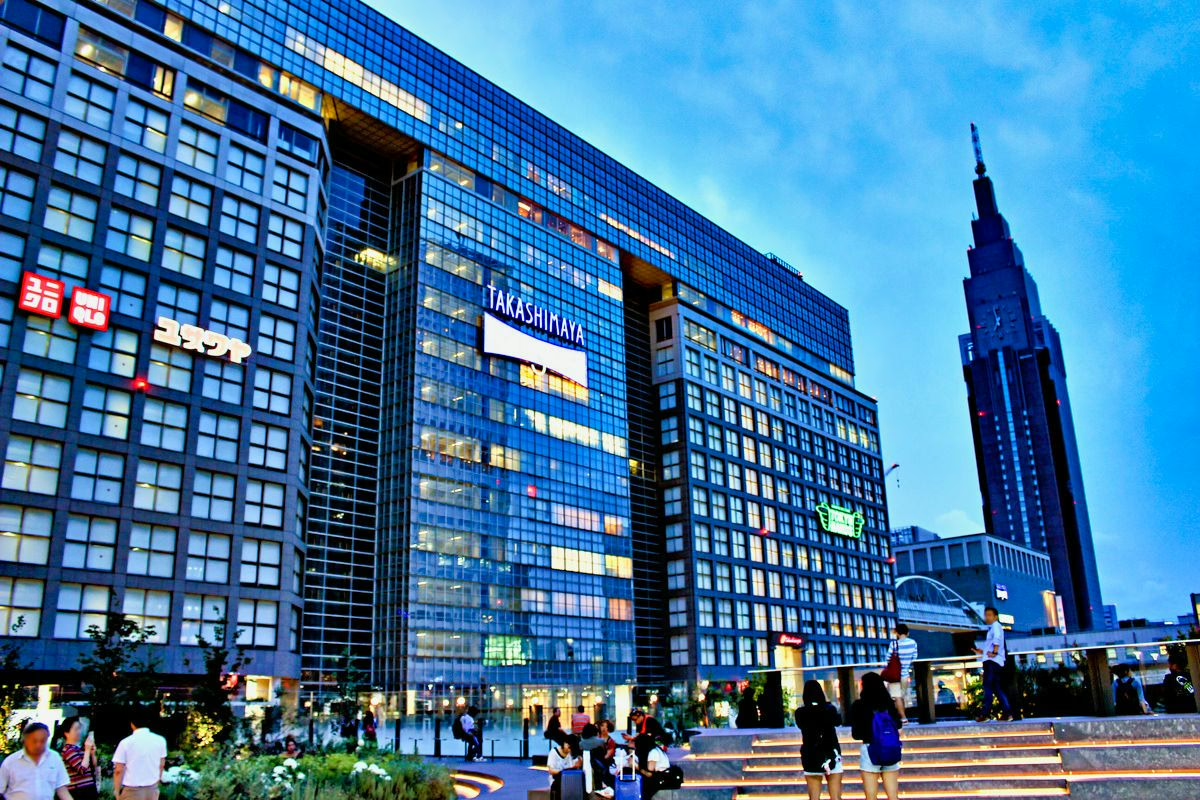
Finding your way through Takashimaya Shinjuku’s sprawling floors becomes infinitely easier once shoppers know exactly where to claim their tax refunds—the dedicated counter sits on the fifth floor’s southwest corner, positioned strategically near the luxury boutiques where international visitors typically rack up their biggest purchases.
This centralized location means you won’t waste precious shopping time hunting down staff or wandering between departments, since everything from designer handbags to premium cosmetics can be processed in one efficient stop.
The counter staff speaks multiple languages and moves quickly through paperwork, transforming what could be a tedious bureaucratic hassle into a smooth two-minute transaction!
Tax-Free Counter Location: Fifth Floor Southwest
Finding the tax-free counter at Takashimaya Shinjuku couldn’t be easier—shoppers need to head straight to the fifth floor’s southwest corner, where a dedicated service desk handles all tax refund procedures with clockwork efficiency.
Here’s what makes this setup brilliant:
- Multiple staff members fluent in English process transactions swiftly
- Shopping cart tips: consolidate purchases before heading up
- Duty free etiquette: have passport ready and receipts organized
Isetan Shinjuku: Fashion Heaven With Smooth Refund Process
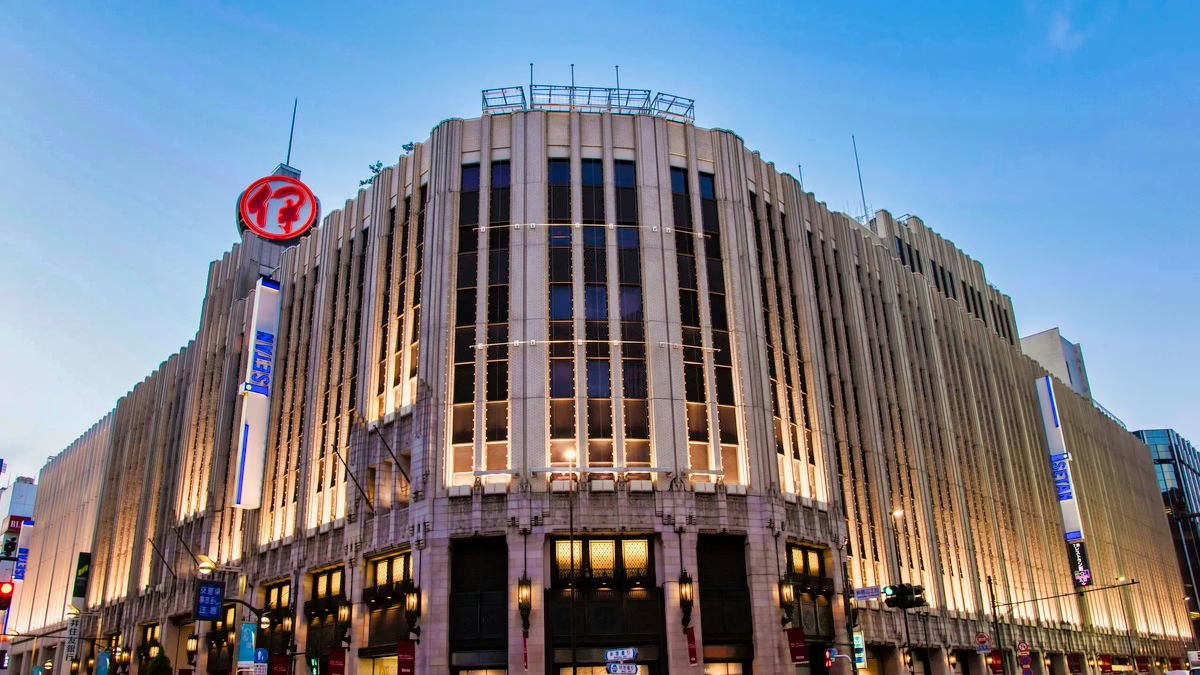
Perched above Shinjuku Station like a beacon for fashion enthusiasts, Isetan stands as one of Japan’s most prestigious department stores—and it absolutely deserves its reputation for making tax-free shopping remarkably painless.
You’ll discover luxury brands spanning Chanel, Dior, and Hermès alongside cutting-edge Japanese designers who define contemporary fashion trends.
The beauty is that Isetan consolidates all tax refunds at dedicated counters on each floor, so you’re never scrambling around searching for where to claim your money back.
Here’s what makes it brilliant: staff members speak excellent English, the process takes roughly five minutes, and they’ll seal your purchases in special bags right there.
The sixth-floor tax refund counter handles overflow during peak hours, ensuring you’re never stuck waiting when adventure calls elsewhere in Tokyo’s electric streets.
Mitsukoshi Ginza: Traditional Department Store Excellence

How does one capture nearly 350 years of retail mastery in a single shopping experience?
Mitsukoshi Ginza delivers exactly that, blending heritage craftsmanship with modern tax-free convenience.
This iconic flagship stands as Japan’s oldest department store, where kimono culture thrives alongside contemporary luxury brands.
Here’s what sets Mitsukoshi apart:
- Premium Japanese tea selections showcasing regional varieties you won’t find elsewhere
- Dedicated kimono floors featuring master artisans and authentic silk garments
- Streamlined tax refund counters with English-speaking staff who actually understand traveler needs
The basement food hall alone justifies your visit—think pristine wagyu, artisanal sweets, and seasonal delicacies that’ll make your suitcase worth checking.
Their tax-free threshold remains standard at ¥5,000, but the curated selection makes reaching it effortless!
Matsuya Ginza: Compact Layout, Efficient Processing
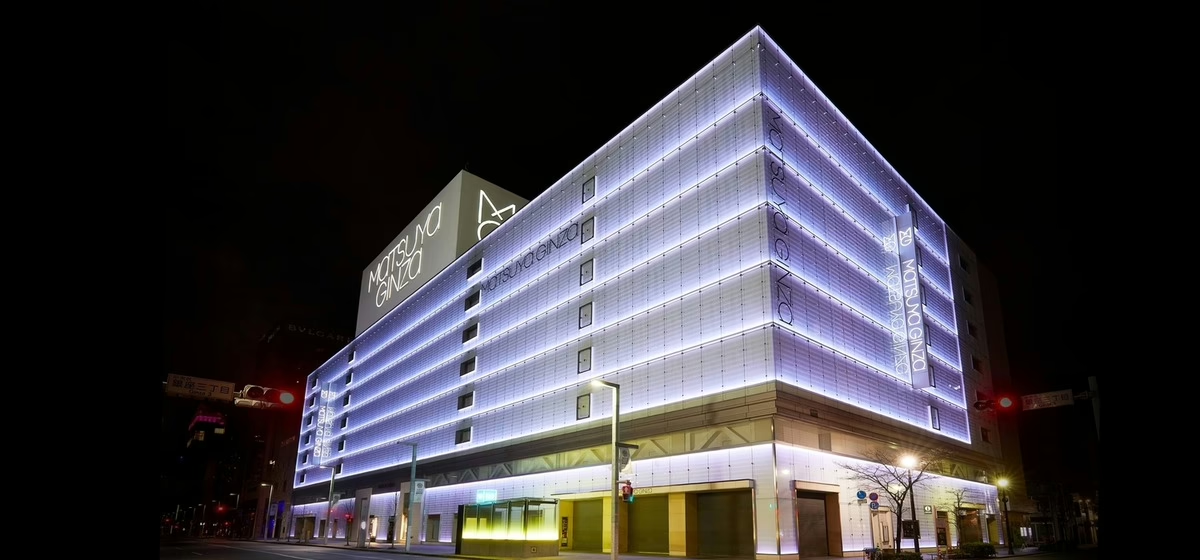
Matsuya Ginza makes steering duty-free purchases refreshingly straightforward with strategically placed Foreign Customer Service Desks on multiple floors.
The main desk sits on the first floor near the Ginza Street entrance, while additional counters on the third and fifth floors mean you won’t waste time hunting for assistance when you’re already loaded down with shopping bags.
English-speaking staff at these stations handle everything from tax refund processing to shipping arrangements, turning what could be a confusing ordeal into a surprisingly quick transaction!
Foreign Customer Service Desks: Where to Get Help
Traversing the sleek, six-floor Matsuya Ginza proves remarkably straightforward compared to Tokyo’s labyrinthine mega-department stores.
The Foreign Customer Service Desk on the first floor makes duty-free shopping even more effortless.
Their multilingual staff demolishes language barriers instantly!
The desk provides:
- Tax refund processing with minimal wait times
- Clear store signage interpretation and navigation assistance
- Purchase consolidation services for multiple-floor shopping sprees
Electronics and Camera Stores With Tax-Free
Tokyo’s electronics giants turn tax-free shopping into an art form, and the savings on cameras, laptops, and gadgets can be absolutely staggering when you combine duty-free privileges with store loyalty programs.
Bic Camera leads the pack with locations scattered across the city like convenience stores, offering stackable point cards that work alongside tax exemptions—yes, you really can double-dip on discounts!
Meanwhile, Yodobashi Camera makes the refund process ridiculously convenient with dedicated tax counters on every single floor.
Labi Yamada Denki crushes it in the home appliance department, and Sofmap occasionally extends tax-free benefits even to pre-owned electronics.
Bic Camera: Multiple Locations, Point Cards Stack With Tax-Free
The Shinjuku West Exit location towers over shoppers with eight massive floors packed with cameras, laptops, smartphones, headphones, and basically every gadget imaginable under one gleaming roof.
Each floor specializes in different categories—from professional photography equipment on the camera floors to gaming consoles and the latest VR headsets higher up—making it easy to navigate even when you’re overwhelmed by choice.
The staff here are remarkably helpful, many speak English, and they’ll walk you through the tax-free process while you rack up those valuable Bic Camera points on top of your duty-free savings!
Shinjuku West Exit: Eight Floors of Everything Electronic
Looking for the ultimate electronics shopping experience in Tokyo?
Bic Camera’s Shinjuku West Exit flagship absolutely dominates with eight towering floors packed with duty free electronics, Japanese souvenirs, and every gadget imaginable!
What makes this location extraordinary:
- Floor-by-floor specialization from cameras to beauty products
- Tax-free shopping combined with loyalty points
- English-speaking staff ready to help navigate your purchases
Yodobashi Camera: Tax Refund Counter on Every Floor
Electronics enthusiasts wandering through Tokyo’s sprawling retail landscape will find few destinations as shopper-friendly as Yodobashi Camera, where the tax-free process has been streamlined to near-perfection.
Unlike luxury brands clustered in Ginza or souvenir shops scattered throughout tourist districts, this electronics giant positions dedicated tax refund counters on every single floor—meaning you’ll never haul your purchases through eight stories just to claim your exemption!
The multilingual staff process paperwork with impressive efficiency, scanning your passport and purchases within minutes.
Pro tip: keep your receipts organized by floor to breeze through even faster.
This strategic setup transforms what’s typically a tedious finale into a seamless part of your shopping adventure, letting you maximize exploration time rather than standing in endless queues at a distant central counter.
Labi Yamada Denki: Strong Appliance Selection
While Yodobashi Camera dominates headlines, savvy shoppers shouldn’t overlook Labi Yamada Denki—a powerhouse retailer where home appliances reign supreme alongside the expected cameras and gadgets.
This chain excels at showcasing rice cookers, air purifiers, and kitchen innovations that make international visitors swoon with envy!
Appliance shopping tips for maximizing your Labi Yamada Denki experience:
- Visit the Ikebukuro flagship location for the most all-encompassing selection, spanning nine floors of tech paradise.
- Compare voltage specifications carefully—Japan’s 100V system differs from most countries.
- Ask staff about export models designed specifically for overseas use.
The tax-free counter processes refunds efficiently, and English-speaking staff navigate you through compatibility questions.
Don’t rush—exploring their appliance floors reveals Japan’s domestic market treasures rarely exported abroad.
Sofmap: Used Electronics Sometimes Qualify Too
Budget-conscious travelers hunting for bargains should make Sofmap their next stop, particularly the tech-savvy shoppers who don’t mind pre-owned gear.
This chain specializes in sofmap electronics ranging from cameras to gaming consoles, with multiple locations clustered around Akihabara’s electric maze.
Here’s the game-changer: certain used gadgets actually qualify for tax-free purchases when they meet specific conditions!
The staff will verify eligibility at checkout, scanning items to determine if they’re exempt-worthy.
The selection of refurbished laptops, smartphones, and photography equipment runs deep, each piece thoroughly tested and graded by condition.
You’ll discover prices slashed 30-70% below retail on name-brand electronics that still pack serious performance.
Just remember to bring your passport and prepare for minimum purchase thresholds—typically ¥5,000—to release those sweet tax savings on secondhand tech treasures.
Fashion and Luxury Shopping Tax-Free Locations
Tokyo’s fashion scene transforms into a tax-free paradise for international shoppers, where glamorous boutiques and cutting-edge designer spaces welcome visitors with both style and savings.
From Ginza’s glittering luxury corridors to Omotesando’s architecturally stunning fashion temples, the city’s premier shopping districts make it incredibly easy to score that Comme des Garçons jacket or Issey Miyake bag without the tax burden.
Tokyo Fashion Areas Comparison: Harajuku vs. Ginza vs. Shibuya Style Districts
Shop smarter in Tokyo: discover which fashion district matches your style and budget across ... Read More
Whether you’re hunting for established European luxury brands or boundary-pushing Japanese designers, these four fashion destinations offer sophisticated tax-free shopping experiences that’ll make your credit card sing (hopefully in a good way).
Ginza Shopping District: High-End Brands Cluster Here

Ginza Six stands as the crown jewel of Tokyo’s luxury shopping scene, a sleek 13-story complex where international fashion giants like Dior, Celine, and Valentino create a tax-free paradise for visitors with serious shopping ambitions.
This architectural marvel, which opened in 2017, houses over 240 premium boutiques spread across sprawling floors that feel more like art galleries than traditional mall spaces.
Shoppers can claim their tax refund right in the building, making it ridiculously convenient to snag that designer handbag without the extra 10% consumption tax weighing down the final bill.
Ginza Six: Modern Mall With International Brands
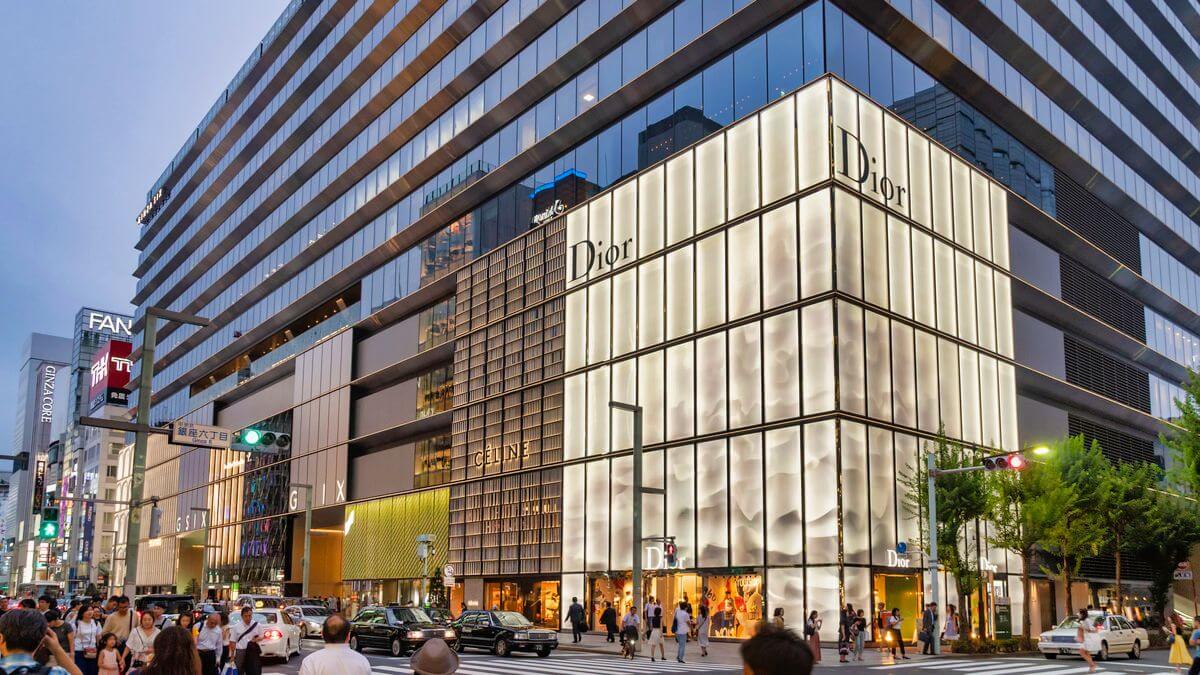
Opened in 2017, this architectural marvel stands as one of Japan’s most impressive retail destinations.
It combines six floors of premium shopping with art installations, rooftop gardens, and a sophisticated dining complex that extends deep below street level.
What makes Ginza Six unmissable:
- Over 240 luxury brands spread across gleaming floors
- Tax-free shopping counter on the second floor
- Tsutaya Books flagship store with English-language travel section
The accessibility here rocks—you’ll navigate duty-free purchases effortlessly!
Omotesando Hills: Designer Fashion in Architectural Beauty
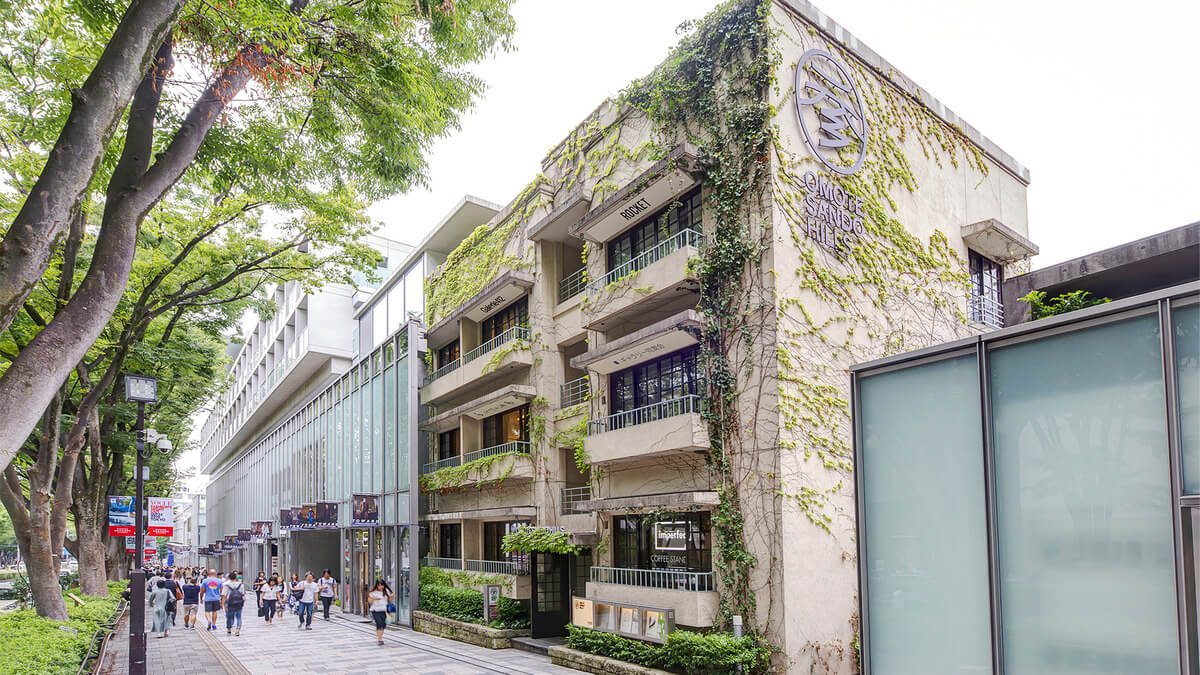
Where else can shoppers find cutting-edge fashion wrapped inside a building that’s literally a work of art?
Omotesando Hills delivers exactly that experience, merging luxury brands with architectural innovation in Tadao Ando’s spiraling concrete masterpiece.
This sloped complex mirrors the Zelkova tree-lined avenue outside, creating a sophisticated shopping journey through designer boutiques you won’t find elsewhere in Tokyo.
International fashion houses share space with emerging Japanese designers, offering tax-free purchases that make splurging feel almost practical!
The building’s gentle spiral descent encourages leisurely exploration, with each level revealing new treasures from Yves Saint Laurent to Jimmy Choo.
Natural light floods through strategic openings, illuminating your potential purchases in the most flattering way possible.
Don’t miss the rooftop terrace where breathtaking city views reward your shopping adventures with Instagram-worthy panoramas.
Tokyo Midtown: Roppongi’s Luxury Shopping Complex
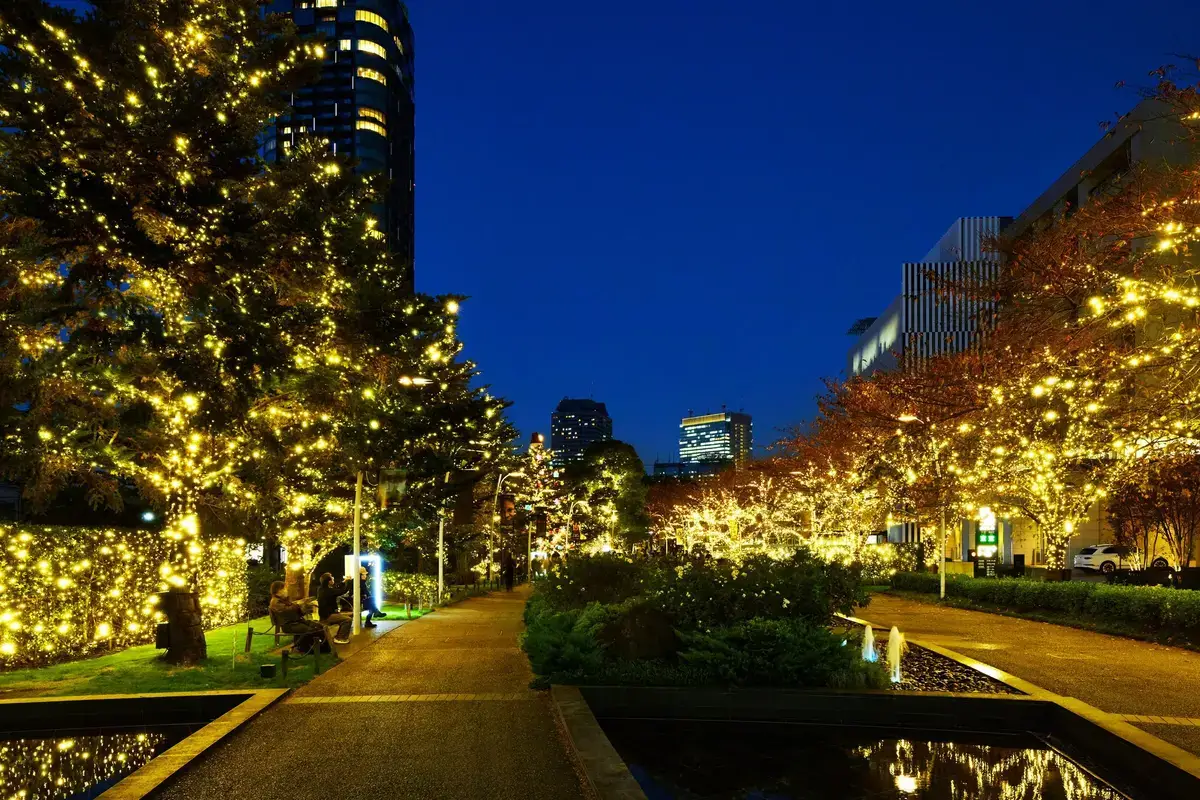
While Omotesando dazzles with its architectural spiral, Tokyo Midtown in Roppongi takes a completely different approach—spreading its luxury across a massive urban campus that functions like a sophisticated city within the city.
This sprawling complex brilliantly merges luxury brands with art galleries, gardens, and even a design museum, creating one of Tokyo’s most liberated shopping districts where you can explore freely without feeling confined.
Here’s what makes Tokyo Midtown exceptional for duty-free hunters:
- Galleria shopping zone featuring international luxury brands alongside cutting-edge Japanese designers
- Tax-free counters strategically positioned for hassle-free refund processing
- Open-air plaza connecting multiple buildings, letting you breathe between boutique visits
The beauty?
You’re never trapped inside—wander outdoors, discover hidden art installations, then duck back into climate-controlled luxury whenever inspiration strikes!
Shibuya Hikarie: Youth Fashion With Tax-Free Services
How does Tokyo’s epicenter of youth culture translate trend-obsessed energy into a duty-free shopping experience?
Shibuya Hikarie delivers exactly that, merging cutting-edge youth fashion with convenient tax-free services across eleven floors of retail paradise.
The store ambiance pulses with the same electric vibe that defines Shibuya itself—bright, bold, and unapologetically modern.
You’ll discover emerging Japanese designers alongside international brands, all curated for Tokyo’s style-savvy crowd seeking liberation through self-expression.
The ShinQs shopping floors (basement through fifth) house everything from cosmetics to contemporary wear, while tax-free counters streamline your refund process.
Navigate seamlessly between kawaii accessories, streetwear labels, and avant-garde pieces that scream individuality.
Located directly connected to Shibuya Station, this architectural beacon makes duty-free shopping effortlessly accessible for freedom-seeking fashion enthusiasts.
Drug Stores and Cosmetics Tax-Free Goldmines
Tokyo’s drug stores represent the ultimate sweet spot for budget-conscious shoppers, combining jaw-dropping discounts with tax-free benefits that can save you up to 20% on already competitive prices.
These colorful storefronts—packed floor-to-ceiling with Japanese skincare, cosmetics, snacks, and quirky gadgets—have become pilgrimage sites for beauty enthusiasts and practical souvenir hunters alike.
Whether you’re hunting for cult-favorite sheet masks, prescription-strength sunscreens, or those viral Japanese eye drops everyone raves about, knowing which chains offer the best deals and least chaotic shopping experiences will transform your Tokyo retail adventure.
Matsumoto Kiyoshi: Yellow Signs Everywhere for Good Reason
Spotting Matsumoto Kiyoshi’s bright yellow signage plastered across Tokyo neighborhoods feels like discovering a treasure map—these ubiquitous drugstores practically beg visitors to step inside and explore their tax-free wonderland of beauty products, skincare, and quirky Japanese health goods.
Those yellow signs aren’t just branding genius; they mark legitimate beauty havens where smart shoppers stock up without the tourist markup.
What makes Matsumoto Kiyoshi absolutely shine:
- Multilingual staff at major locations who actually understand tax-free procedures
- Competitive pricing that often undercuts airport duty-free shops by 20-30%
- Massive selection spanning 15,000+ products including cult-favorite Japanese sunscreens and sheet masks
The Shinjuku and Shibuya flagship stores stay open until 10 PM, perfect for post-dinner shopping sprees when you’re energized and ready to conquer Japan’s skincare empire!
Sundrug: Competitive Pricing Plus Tax Savings
Where do savvy Tokyo travelers go when they’ve already cleaned out Matsumoto Kiyoshi but still need more Japanese beauty ammunition?
Sundrug, that’s where!
This powerhouse chain matches its yellow competitor step-for-step with equally aggressive sundrug pricing that’ll make your wallet sing.
The real magic happens when you stack their already-low prices with tax-free shopping—suddenly that ¥3,000 serum becomes genuinely affordable.
Sundrug stores pepper major shopping districts like Shibuya, Shinjuku, and Ikebukuro, each location stocked with Japanese skincare treasures, makeup must-haves, and those quirky health products you can’t find back home.
The tax savings alone justify visiting multiple locations, and let’s be honest, comparing prices between drugstores has become its own entertaining Tokyo sport for budget-conscious beauty hunters seeking maximum value.
Tomod’s: Less Crowded Alternative Near Major Stations
The beauty of Tomod’s lies in its remarkably inclusive tax-free policy—seriously, almost everything in the store qualifies for duty-free savings once you hit that ¥5,000 minimum purchase threshold.
Unlike some retailers that cherry-pick which products get the tax exemption, Tomod’s extends this benefit across their entire range, from premium Japanese skincare and makeup to everyday essentials like vitamins, supplements, hair care products, and even snacks.
This extensive approach means you can mix and match practical items with luxury finds, making it ridiculously easy to reach that minimum while stocking up on all those cult-favorite Japanese beauty products your friends begged you to bring back!
Product Categories That Qualify: Almost Everything Here
Tomod’s operates as Tokyo’s best-kept secret among drugstore chains, offering spacious aisles and minimal tourist crowds compared to the chaotic Matsumoto Kiyoshi stores where visitors often jostle for shelf space.
Their tax-free program covers an impressive range:
- Skincare and cosmetics (from luxury brands to affordable Japanese favorites)
- Medical supplies and supplements (perfect for souvenir shopping)
- Snacks, beverages, and daily essentials
Don Quijote: Discount Paradise With Tax-Free Floors
Shopping fanatics seeking the ultimate duty-free experience in Tokyo will find their nirvana at Don Quijote, affectionately nicknamed “Donki” by locals who practically live in its gloriously chaotic aisles.
This discount paradise operates multiple floors of tax-free shopping across Tokyo, stuffed floor-to-ceiling with everything from Japanese snack souvenirs to electronics, cosmetics, and bizarre novelties you never knew existed.
Unlike sterile Tokyo street markets, Donki pulses with neon-lit energy 24/7, blasting J-pop while shoppers hunt treasures through deliberately maze-like layouts designed to maximize discovery.
The dedicated tax-free counters streamline your refund process, handling paperwork efficiently so you can maximize savings on already discounted merchandise.
Pro tip: hit the Shibuya or Shinjuku locations after midnight when crowds thin but the full inventory remains—you’ll navigate more freely through pharmaceutical sections, beauty products, and quirky gift items that define Japan’s wonderfully eccentric retail culture!
Traditional Japanese Products and Souvenirs
Tokyo’s traditional craft shops and souvenir stores offer some of the most memorable tax-free shopping experiences in the city, from century-old establishments to modern galleries showcasing regional artisans.
Whether browsing the tourist-friendly aisles of Oriental Bazaar in Harajuku, perusing government-certified masterworks at Japan Traditional Crafts Aoyama Square, or hunting for deals along the increasingly tax-free friendly Nakamise-Dori in Asakusa, visitors can score authentic Japanese treasures while saving serious yen.
Also read: Tokyo Souvenir Guide
Takumi in Ginza stands out as a carefully curated gem where expert buyers handpick the finest folk crafts from every corner of Japan, making it ridiculously easy to find quality without wandering through dozens of shops!
Oriental Bazaar Harajuku: Tourist-Friendly Shopping Since 1950
Nestled along Omotesando-dori since 1950, Oriental Bazaar stands as Harajuku’s quintessential tourist treasure trove, where generations of visitors have discovered authentic Japanese souvenirs without the language barrier headaches.
This three-story emporium caters brilliantly to international shoppers seeking everything from elegant kimono to traditional tea ceremonies equipment, all while the friendly English-speaking staff guide your explorations.
The bazaar’s curated selection includes:
- Antique woodblock prints and calligraphy for art enthusiasts craving cultural depth
- Yukata, happi coats, and accessories perfect for festival adventures or home decoration
- Ceramics and lacquerware ranging from affordable trinkets to investment-worthy pieces
After browsing, you’ll find yourself strategically positioned to explore Harajuku’s famous Takeshita Street, where Japanese street food vendors tempt passersby with rainbow-colored cotton candy and savory crepes that fuel your continued shopping expedition.
Takumi Ginza: Curated Crafts From All Over Japan
While Oriental Bazaar excels at gathering popular souvenirs under one roof, serious craft collectors eventually find their way to Takumi in Ginza, where Japan’s regional artisan traditions receive the gallery treatment they deserve.
This compact boutique showcases impeccably curated Japanese craft from every prefecture—Aizu lacquerware, Bizen pottery, Nara brushes, and handwoven textiles that represent generations of specialized skill.
Unlike generic Ginza boutiques, Takumi’s knowledgeable staff can trace each item’s lineage and explain techniques that transform raw materials into functional art.
You’ll discover pieces unavailable elsewhere: bamboo baskets from Oita masters, indigo-dyed fabrics following centuries-old methods, wooden combs carved with astonishing precision.
Prices reflect genuine craftsmanship rather than tourist markup, and the tax-free shopping benefit makes investing in authentic heritage pieces surprisingly accessible for travelers seeking meaningful souvenirs beyond mass-produced trinkets.
Japan Traditional Crafts Aoyama Square: Government-Backed Quality
When government certification meets shopping convenience, travelers discover Japan Traditional Crafts Aoyama Square—a two-story treasure house where the Ministry of Economy, Trade and Industry officially endorses every item on the shelves.
This quality assurance transforms browsing into confident buying, knowing each ceramic bowl, textile, and lacquerware piece meets rigorous national standards for traditional crafts excellence.
The selection spans Japan’s artisan landscape:
- Pottery and porcelain from renowned kilns in Arita, Bizen, and Kutani
- Textiles and fabrics including Kyoto silk, Okinawan bingata, and indigo-dyed works
- Lacquerware and woodcrafts featuring centuries-old techniques from master craftspeople
Located steps from Aoyama-itchome Station, this government-backed showroom eliminates guesswork about authenticity.
Tax-free shopping applies to purchases exceeding ¥5,000, making premium souvenirs surprisingly accessible!
Nakamise-Dori Asakusa: Some Shops Offer Tax-Free Now
How does Tokyo’s oldest shopping street adapt to modern tourist needs?
Nakamise-dori Asakusa now features select vendors offering tax-free shopping alongside their traditional wares—a brilliant fusion of heritage and convenience!
This lively 250-meter stretch leading to Senso-ji Temple showcases everything from handcrafted fans and wooden kokeshi dolls to crispy senbei crackers and quirky cat-themed souvenirs.
While not every stall participates in the tax refund program, look for the prominent “Tax-Free” signage displayed at participating shops.
Pro tip: consider early morning shopping before the tour groups arrive, when you’ll actually have breathing room to examine those beautiful indigo tenugui towels and negotiate with shopkeepers who appreciate dedicated treasure hunters.
The atmospheric lanterns overhead and traditional storefronts create Instagram-worthy backdrops while you hunt for authentic keepsakes.
Shopping Malls and Complex Facilities
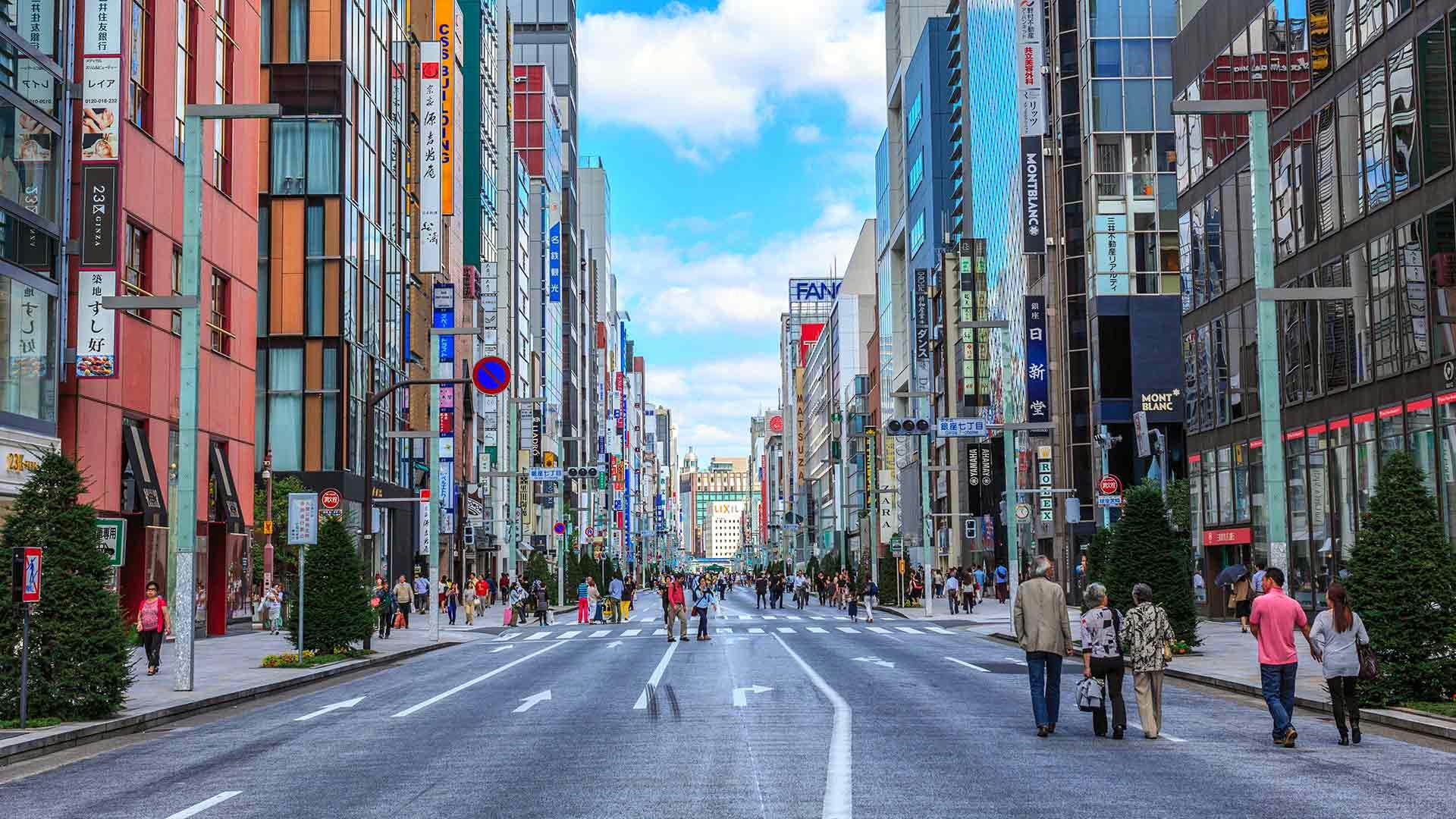
Tokyo’s major shopping complexes transform duty-free hunting into an all-day adventure, combining multiple stores, restaurants, and entertainment under one roof where you can maximize your tax savings without zigzagging across the city.
These mega-facilities cater specifically to international visitors with multilingual staff, tourist lounges, and streamlined tax refund counters that make claiming your exemptions incredibly smooth.
From sleek stations packed with edible souvenirs to glamorous hillside destinations and waterfront outlet paradises, these shopping hubs let you knock out your entire gift list while actually enjoying the experience!
Tokyo Station Gransta: Tax-Free Food Souvenirs Before Departure
Why haul heavy souvenir bags around Tokyo when travelers can snag their tax-free treats right before catching the shinkansen?
Gransta, Tokyo Station’s underground shopping haven, revolutionizes last-minute gift hunting with its stellar tax-free counter that processes purchases efficiently.
The food halls overflow with premium local food options, from Hokkaido dairy delights to Kyushu wagyu specialties, all wrapped in gorgeous souvenir packaging that screams “I traveled Japan!”
Top Tax-Free Picks at Gransta:
- Seasonal wagashi (traditional sweets) featuring limited-edition flavors
- Regional sake bottles in travel-friendly sizes with protective wrapping
- Artisanal snack boxes combining matcha treats, senbei crackers, and mochi varieties
Smart travelers breeze through immigration with fresh purchases instead of lugging crushed cookies from day one of their adventure!
Roppongi Hills: High-End Shopping With Tourist Services
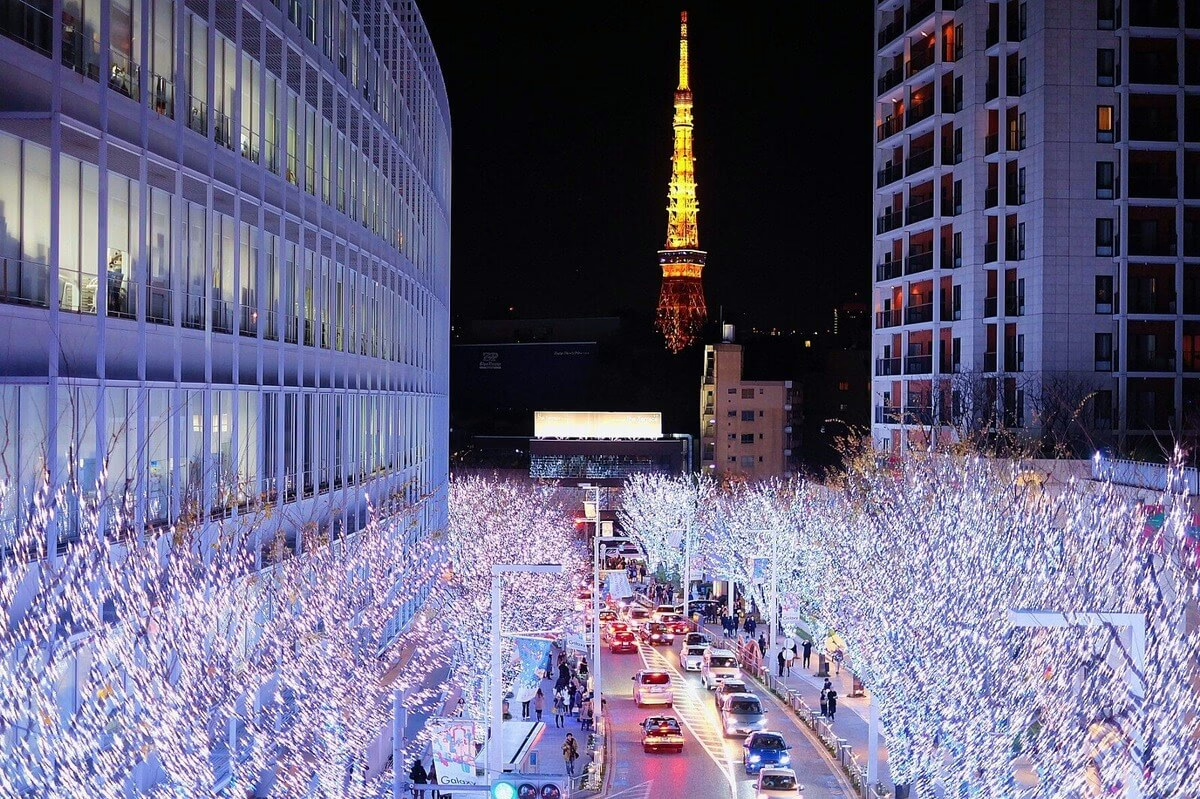
Beyond shopping, this district pulses with Tokyo nightlife—rooftop bars with skyline views and clubs that shift seamlessly from your retail therapy.
Time your visit during cultural festivals held in the outdoor arena, where traditional performances meet contemporary celebrations.
The Mori Art Museum upstairs adds intellectual depth to your spending spree, making this complex the ultimate multitasking paradise for travelers who refuse to choose between culture and commerce.
Odaiba Venus Fort: Outlet Prices Plus Tax Savings
Venus Fort makes claiming your tax refund incredibly straightforward—just head to the information floor where the tax-free counter sits ready to process your paperwork.
Most large shopping complexes in Tokyo follow this same practical setup, centralizing tax refund services on floors dedicated to guest services, making them easy to locate even if you’re rushing through a shopping spree.
Look for signs pointing to “Information” or “Tax Free,” and you’ll typically find helpful staff members who can guide you through the quick refund process while you catch your breath between outlet bargain hunts!
Tax-Free Counter Locations: Usually on Information Floors
Shopping malls and department stores in Tokyo typically position their tax-free counters on information floors—usually the first floor near main entrances or on designated service levels where customer support desks cluster together.
Locating these counters becomes effortless when you:
- Check shopping district maps posted near escalators—they’ll highlight tax-free services with passport icons.
- Look for multilingual signage directing you toward customer service areas.
- Ask duty free beauty counters, as staff always know where to process refunds!
Airport Duty-Free Shops: Pre-Departure Options
Airport duty-free shopping represents the final opportunity to snag those tax-free deals before boarding, and both Narita and Haneda offer surprisingly robust options that go way beyond the typical perfume-and-liquor lineup.
The real trick lies in understanding which purchases make more sense at the airport versus downtown Tokyo, since not everything behind the security gates actually offers better prices despite the duty-free label.
Timing matters too—arriving early enough to browse without that stressful gate-dash panic transforms airport shopping from a frantic grab-and-go into a genuinely rewarding pre-flight experience.
Narita Airport Terminal Shopping: After Security Advantages

Once travelers pass through security at Narita Airport, they’ll discover something surprising—the duty-free cosmetics and alcohol selections actually outshine most downtown Tokyo shops, offering exclusive travel retail sets, limited editions, and prices that make even savvy shoppers do a double-take.
Japanese whisky enthusiasts, in particular, should save their yen for this moment, since the airport stocks rare bottles and commemorative releases that vanish quickly from city shelves.
The beauty counters rival department stores with their range of SK-II, Shiseido, and international luxury brands, plus those genius travel-size sets perfect for testing new products without commitment.
Cosmetics and Alcohol: Better Selection Than Downtown
Why settle for the limited cosmetics displays in downtown department stores when Narita’s post-security duty-free zones offer an astonishing array of Japanese and international beauty brands at tax-free prices?
The selection genuinely dazzles!
Airport duty-free shops excel with:
- Luxury skincare sets unavailable elsewhere, including exclusive travel editions
- Premium wine selection spanning French Bordeaux to Japanese whisky
- Korean beauty products at unbeatable prices
Stock up before departure!
Haneda Airport International Terminal: Compact But Complete
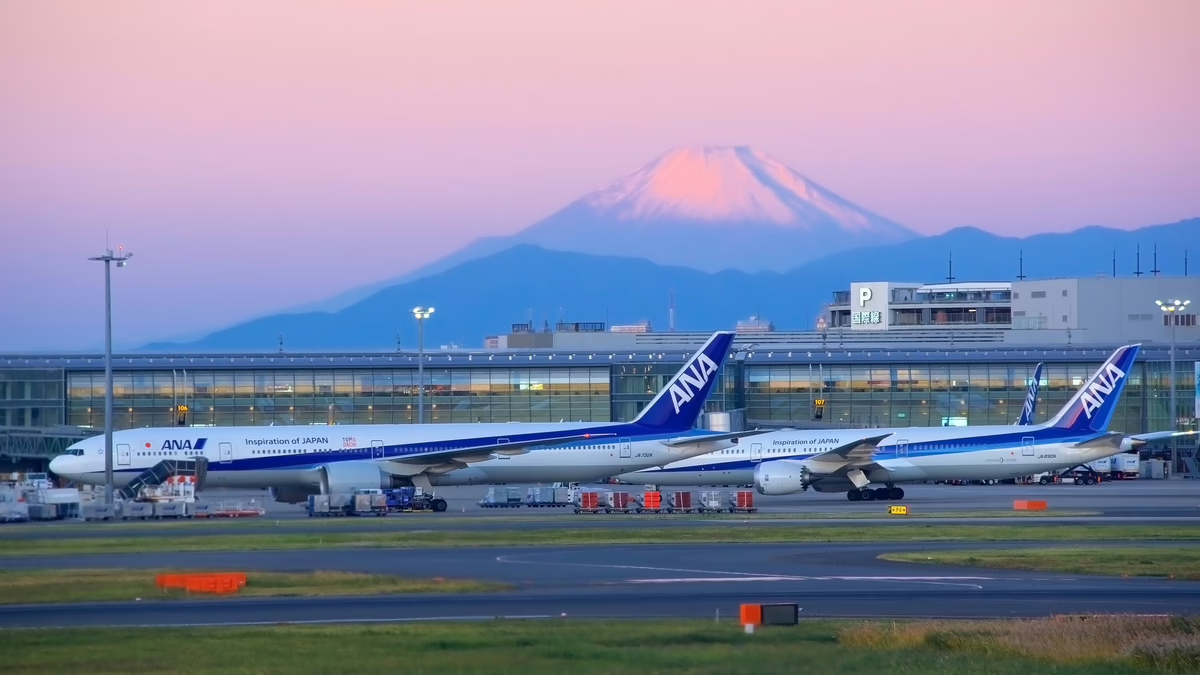
Travelers departing from Haneda often discover that smaller doesn’t mean sacrificing selection—the International Terminal’s duty-free zone packs an impressive variety of Japanese specialties, cosmetics, and spirits into its streamlined space.
Browse luxury souvenirs like exquisite ceramics and lacquerware alongside practical favorites such as matcha snacks and Kit-Kat flavors you won’t find elsewhere.
The layout works brilliantly for last-minute shoppers, with clearly marked sections that let you grab cultural crafts, premium sake, or Shiseido skincare without racing through endless corridors.
What really sets Haneda apart?
The shops stay open until the final departure, giving you maximum shopping flexibility even on late-night flights.
Plus, staff typically speak excellent English and pack fragile items with ninja-level precision, ensuring your purchases survive the journey home intact!
Downtown vs. Airport Prices: When Each Makes Sense
Running out of time shouldn’t mean running out of options—smart travelers know that Narita’s duty-free terminals hide surprisingly effective last-minute solutions for forgotten gifts and essential souvenirs.
The key lies in knowing which items actually offer genuine value at airport prices (Japanese whisky, cosmetics, and Kit Kat flavors you missed downtown) versus what’s simply overpriced desperation shopping.
Armed with thirty minutes and a strategic approach, travelers can still snag authentic Tokyo mementos without the regret that usually accompanies panic-buying at gates.
Last-Minute Souvenir Strategies That Actually Work
When the clock’s ticking down to boarding time and those omiyage obligations haven’t been fulfilled, smart shoppers know that airport duty-free isn’t necessarily the panic button it appears to be—it’s actually a strategic finishing move.
Last minute shopping souvenir hacks that actually deliver:
- Kit Kat flavor collections – compact, lightweight, quintessentially Japanese
- Yoku Moku cigare cookies – elegant packaging screams premium without the premium price
- Royce’ chocolate – refrigerated airport sections maintain freshness during delays
Step-by-Step Tax Refund Process at Stores
Mastering Tokyo’s tax-free shopping process is refreshingly straightforward once shoppers understand the essential steps that unlock those valuable savings.
The journey begins with spotting those telltale “Tax-Free” logos throughout stores.
It requires hitting specific minimum purchase thresholds (usually ¥5,000 for consumables), and culminates at designated tax-free counters where staff will work their bureaucratic magic.
Perhaps most importantly, those receipts and documents get stapled directly into passports—a quirky but crucial detail that ensures smooth sailing through customs when departing Japan!
Finding Tax-Free Eligible Items: Look for the Logos
How does a shopper identify which items qualify for tax-free purchases among Tokyo’s seemingly endless retail options?
The answer lies in spotting distinctive logos that signal tax-exempt status, making your shopping expedition remarkably straightforward!
Key logos to watch for:
- “Japan Tax-Free Shop” red logo – The official government-authorized symbol displayed prominently at qualifying retailers.
- Bilingual “Tax-Free” signage – Often positioned near entrances, cash registers, or gift wrapping stations.
- Store directory indicators – Shopping complexes mark participating shops on maps and digital displays.
These visual markers appear throughout major department stores, electronics retailers, and specialty boutiques.
Smart shoppers scope out these symbols before committing store hours to browsing.
The logos guarantee hassle-free refunds without surprises at checkout, empowering savvy international visitors to maximize their purchasing freedom!
Minimum Purchase Requirements: Hitting the Threshold
Understanding the monetary thresholds transforms casual browsing into strategic tax-free victories across Tokyo’s retail landscape!
General merchandise requires a minimum purchase of ¥5,000 (roughly $35-40) at a single store on the same day, while consumables like cosmetics, snacks, and beverages need the same threshold.
Here’s the liberating part: you can combine different tax-free eligible items to reach that magic number, making it surprisingly easy to qualify even when buying smaller luxury souvenirs.
Smart shoppers understand that proper shopping etiquette means keeping receipts organized and purchasing from the same retailer’s tax-free counter rather than splitting transactions across multiple locations.
Pro tip: if you’re hovering just below ¥5,000, ask staff about combining departments—many stores count purchases from different floors toward your total!
Bringing Items to Tax-Free Counter: What Happens Next
The tax-free counter process moves surprisingly fast—staff members will scan the shopper’s passport, verify their temporary visitor status, and complete the necessary paperwork in about five minutes or less.
Most stores use digital systems that automatically generate the required tax exemption forms, which means travelers won’t need to fill out lengthy documents by hand.
The clerk attaches a special receipt to the passport (don’t remove it until leaving Japan!), staples the purchase record inside, and sends the shopper on their way with sealed bags containing their duty-free treasures.
Passport Scanning and Form Completion: Five Minutes Maximum
Once a shopper hands over their selections at the tax-free counter, staff members spring into action with practiced efficiency that rivals a Tokyo train conductor’s punctuality.
The passport scanning and form completion process unfolds seamlessly:
- Staff scan your passport’s data page
- Digital forms populate automatically with your information
- You sign electronically or on paper
The entire transaction wraps up in five minutes maximum—pure liberation from bureaucratic tedium!
Receipt Stapling: Those Documents Stay in Your Passport
After the tax-free counter staff processes the paperwork, they’ll staple those precious documents—the purchase record and receipts—directly into the traveler’s passport.
And here’s the essential part: those papers must remain untouched until reaching the airport.
Resist any urge to remove them early, no matter how annoying they feel flapping around in that passport!
The stapled forms serve as official proof that tax-free goods are leaving Japan, and customs officials at the airport are the only ones authorized to remove them during the departure process.
Removing Stapled Forms: Only at Airport Departure
- Keep all stapled receipts secure throughout your Tokyo adventure.
- Present your passport with attached documents at customs before checking luggage.
- Officials perform staple removal after verifying your purchases.
Don’t touch those staples yourself—premature removal forfeits your refund completely!
Consumable Goods Special Rules
Consumable goods—think snacks, sake, skincare serums, and supplements—follow a completely different set of tax-free rules that can trip up even experienced duty-free shoppers if they’re not careful!
The biggest gotcha is that stores must seal your cosmetics and cookies in special tamper-proof bags that you absolutely cannot open until you’ve left Japan, which means no sampling that Kit Kat flavor assortment on your last night in Shibuya.
The good news is that consumables have a lower ¥5,000 minimum purchase threshold compared to general goods, making it easier to snag tax-free deals on smaller hauls of Japanese beauty products or gourmet treats.
What Counts as Consumable: Food, Drinks, Medicine, Cosmetics
Japan’s tax-free shopping system draws a crucial distinction between consumable and general goods—and understanding this difference can save travelers from awkward checkout confusion!
Consumables include items you’ll use up during your trip, and they’re subject to specific food regulations and medicine restrictions that smart shoppers need to know.
Here’s what qualifies as consumable:
- Food and beverages – Everything from trendy Tokyo snacks to premium sake bottles
- Cosmetics and toiletries – Skincare products, makeup, shampoos, and those famous Japanese face masks
- Medicines and supplements – Over-the-counter drugs (with medicine restrictions on quantity) and health products
Special Packaging Requirements: Sealed Bags You Can’t Open
When shoppers purchase tax-free consumables in Tokyo, they’ll encounter a distinctive packaging ritual that catches many first-timers off guard—cashiers will seal their purchases in special tamper-evident bags that absolutely cannot be opened until leaving Japan.
These sealed bags feature security strips and official customs stamps, transforming your snacks and skincare into forbidden treasures you’ll carry around town.
Yes, the open restrictions feel counterintuitive when you’ve just bought chocolate or face masks you’re dying to try!
Breaking that seal early means forfeiting your tax refund and potentially facing penalties at airport customs.
Store staff will carefully explain this rule—some even attach multilingual warning labels—because they want you succeeding at duty-free shopping.
Keep those sealed bags pristine until you’ve cleared Japanese immigration, then celebrate your savings by ripping them open!
¥5,000 Minimum for Consumables: Lower Than General Goods
Why do Tokyo’s tax-free shopping rules favor budget-conscious snack hoarders and beauty product enthusiasts?
The consumable limits threshold sits remarkably lower than general merchandise, making your skincare splurge totally achievable!
While electronics and clothing require ¥5,000 minimum spend, consumables clock in at just ¥5,000 too—but here’s the twist: they’re processed separately and come with different packaging requirements.
Understanding these consumable limits release serious savings:
- Food items, cosmetics, and medicine qualify under the lower threshold
- ¥50,000 maximum per consumable category prevents excessive stockpiling
- Combine multiple consumable purchases from different departments to reach minimum spend
This dual-threshold system means you can score tax-free matcha KitKats and sheet masks without dropping major yen, giving travelers unprecedented flexibility in their duty-free adventures!
Using Items Before Departure: Why You Really Shouldn’t
Those matcha KitKats and fancy face serums purchased tax-free come with one massive catch that trips up countless travelers: you absolutely cannot open or use them before leaving Japan.
Customs officials can literally revoke your tax exemption and demand immediate payment if they catch you using items before departure.
Those special transparent packaging bags exist for a reason—they’re your proof of compliance.
Breaking the seal means losing your savings, and trust me, airport inspectors don’t mess around during spot checks.
The consumables rule particularly stings because who doesn’t want to snack on those limited-edition treats during a long flight?
Resist temptation, keep everything sealed, and wait until you’re airborne over international waters.
Your wallet will thank you for exercising restraint.
General Goods Categories and Regulations
General goods open up a whole new world of tax-free shopping in Tokyo, covering everything from the latest smartphones and cameras to designer handbags, sneakers, and traditional Japanese crafts.
The ¥5,000 minimum purchase requirement now applies here too (thanks to that 2021 rule change we mentioned earlier), putting general goods on equal footing with consumables.
Here’s the good news though: unlike those sealed consumable bags you can’t touch, you’re typically allowed to wear that new jacket or use those headphones right away—just make sure you actually take everything out of Japan within the required timeframe!
Electronics, Clothing, Accessories, and More
What transforms a simple shopping trip into a tax-free treasure hunt?
The incredible variety of eligible goods waiting for your passport!
Tokyo’s duty-free wonderland spans everything from cutting-edge gadgets to haute couture, giving you unprecedented access to Japan’s finest merchandise without the tax burden.
Here’s what qualifies for your tax-free adventure:
- Electronics & Cameras – Tokyo’s legendary tech scene, from compact mirrorless cameras to noise-cancelling headphones
- Fashion & Accessories – Designer handbags, watches, cosmetics, and traditional kimono pieces
- Gourmet Items – Premium sake, artisanal snacks, and regional delicacies (consumables require special packaging)
Pro tip: Check store hours before heading out, and don’t skip the complimentary gift wrapping services that many retailers offer.
Your purchases become beautifully packaged souvenirs, sealed and ready for your journey home!
¥5,000 Minimum Purchase: Same as Consumables Now
Since Japan’s 2021 tax reform, savvy shoppers have celebrated a game-changing update: the minimum purchase threshold for general goods dropped from ¥10,000 to just ¥5,000, matching the requirement for consumables!
This means electronics, clothing, accessories, and non-edible items now qualify for tax-free status at the same lower threshold.
This change allows you to shop more flexibly.
Picture yourself browsing luxury brands in Ginza or hunting treasures in quirky souvenir shops—either way, you’ll hit that ¥5,000 mark faster than ever.
The unified system eliminates confusion, letting you mix purchases strategically.
Grab a designer wallet, couple it with some tech gadgets, and watch your savings stack up!
This traveler-friendly reform puts more money back in your pocket, whether you’re splurging on high-end fashion or collecting unique keepsakes across Tokyo’s diverse shopping districts.
Taking Items Home: Export Requirements Explained
The tax-free shopping perks come with one essential catch that every traveler must understand: those gorgeous items you just scored need to actually leave Japan with you!
The item export process isn’t complicated, but ignoring these rules could mean paying back that sweet tax refund at the airport.
Here’s what matters for export documentation:
- Sealed packages must stay sealed until you’ve cleared Japanese customs at departure.
- Keep all receipts and tax-free forms readily accessible in your carry-on for inspection.
- Present purchases to customs officers if requested, though random checks are relatively rare.
Smart shoppers treat their duty-free haul like precious cargo, resisting the temptation to crack open that packaging until they’re wheels-up and homeward bound!
Wearing Purchased Clothing: Usually Fine Unlike Consumables
Now here’s where Japan’s tax-free system gets wonderfully practical for fashion lovers: clothing and accessories fall under “general goods,” which means shoppers can actually wear or use these items before departure—no sealed package requirement necessary!
Unlike consumables such as cosmetics and snacks that must remain sealed until you leave Japan, wearing clothing immediately poses zero problems.
This clothing comfort advantage transforms your shopping experience entirely.
You can rock that new Uniqlo jacket straight out of Ginza, break in those sleek leather boots from Shibuya’s department stores, or accessorize with that perfect scarf while still exploring Tokyo’s neighborhoods.
The freedom to enjoy your purchases immediately, rather than watching them collect dust in sealed bags, makes tax-free fashion shopping revitalizing and utterly practical for travelers who value both style and spontaneity.
Combining Multiple Store Purchases
Smart shoppers know that Tokyo’s duty-free landscape gets even better when you master the art of combining purchases from multiple stores—a game-changing strategy that can push you over those minimum spending thresholds!
The secret lies in timing your shopping spree within the same day, keeping those receipts meticulously organized (trust me, that crumpled slip from the basement electronics shop matters), and discovering the magic of multi-store tax refund centers scattered throughout tourist hubs.
These savvy techniques transform what could be a chaotic shopping marathon into a streamlined, money-saving adventure that maximizes every yen of your tax-free benefits.
Same-Day Shopping: Timing Your Purchases Strategically
When shoppers split their duty-free purchases across multiple stores throughout Tokyo—say, grabbing cosmetics at Don Quijote in Shibuya, electronics at Bic Camera in Shinjuku, and designer goods at Isetan in Ginza—they need to keep all those receipts and purchased items together until they reach the airport.
Smart timing maximizes your shopping freedom while avoiding rush hours that eat into your exploration time!
Consider these strategic approaches:
- Start early morning when stores open to score deals before crowds descend
- Hit late night shopping spots like 24-hour Don Quijote for stress-free browsing
- Map your route efficiently to cluster nearby stores, minimizing transit time between purchases
Pack everything in your carry-on, keep those duty-free receipts accessible, and you’ll breeze through customs verification!
Receipt Collection: Organizing for Smooth Processing
Document preservation means more than stuffing crumpled papers into pockets!
Staple related receipts together when combining purchases from multiple stores toward that ¥5,000 minimum threshold.
Photograph each receipt as backup—smartphones become lifesavers when originals mysteriously disappear.
This systematic approach liberates travelers from last-minute scrambling, ensuring every hard-earned yen flows back where it belongs: funding your next Tokyo adventure.
Multi-Store Tax Refund Services: Tourist Information Centers
While Tourist Information Centers offer the incredible convenience of bundling tax refund claims from multiple smaller shops into one streamlined transaction, this service typically comes with a processing fee that ranges from 1-2% of the refund amount.
Think of it as paying for the privilege of not having to track down individual store receipts or worry about meeting minimum purchase thresholds at each location—the fee fundamentally buys back your time and sanity!
Most travelers find the charge worthwhile when they’ve shopped at numerous boutiques and specialty stores, though budget-conscious shoppers should calculate whether the convenience truly outweighs the cost of their particular situation.
Service Fees: When Convenience Costs Extra
Although Tokyo’s duty-free shopping landscape offers incredible savings, savvy travelers should know that certain convenience services come with price tags that can nibble away at those hard-earned tax refunds.
Watch for these service fees and hidden charges:
- Multi-store consolidation services typically charge 500-1,000 yen per transaction
- Express processing fees at airports ranging from 300-800 yen
- Currency conversion markups when refunds aren’t issued in yen
Credit Card vs. Cash Refunds
When travelers claim their tax refunds in Tokyo, they face a pivotal decision that directly impacts their wallets: should they pocket immediate cash or wait for a credit card reimbursement?
Most Japanese stores overwhelmingly favor the cash-back method because it’s instant, hassle-free, and eliminates the dreaded foreign transaction fees that can devour up to 3% of your hard-earned refund.
While credit card refunds might sound convenient, the reality involves processing delays of 1-3 months, currency conversion uncertainties, and potential complications that make cold, hard yen the indisputable champion for speed and simplicity!
Immediate Cash Back: Most Common Method in Japan
Unlike many countries where tax refunds arrive weeks later via mail or credit card reversals, Japan’s duty-free system operates on instant gratification—shoppers walk out with their savings immediately in hand.
This cash back approach transforms the typically tedious refund process into something refreshingly simple and tourist-friendly.
Here’s how the immediate refund works in Tokyo’s major shopping districts:
- Purchase completion – The cashier calculates your tax exemption at checkout, deducting the 10% consumption tax right there.
- Documentation – Your passport gets stamped and receipts are stapled inside for customs verification.
- Instant savings – You receive either cash back or a reduced total on your credit card immediately.
No waiting periods, no complicated forms mailed home, no uncertainty—just pure, instant savings that let you reinvest in more adventures across Tokyo’s incredible shopping landscape!
Credit Card Refunds: Processing Time and Complications
While most Tokyo retailers stick to the instant cash-back model, some department stores and international chain boutiques—particularly those catering to luxury shoppers—process duty-free purchases through credit card refunds instead.
And this is where things get a bit trickier.
Credit card processing means you’ll pay full price upfront, then wait for that sweet tax refund to appear on your statement weeks later.
The timeline?
Typically 30-90 days, though some travelers report even longer waits.
Refund complications pop up when exchange rates fluctuate between purchase and refund dates, potentially shortchanging you a few yen.
Currency conversion fees might also nibble away at your savings.
If you’re after maximum freedom and flexibility with your travel budget, immediate cash back wins hands down!
Which Works Better: Cash Wins for Speed and Simplicity
So which refund method actually deserves the gold medal?
Cash transactions reign supreme in Tokyo’s duty-free landscape, delivering your money faster than you can say “arigato.” While credit card refunds technically work, they force travelers into a waiting game that contradicts the whole point of immediate tax relief.
Here’s why cash wins every time:
- Instant gratification – Walk away with yen in hand, ready for ramen adventures or last-minute souvenir splurges
- Zero processing delays – No anxious bank statement checking or currency conversion confusion weeks later
- Universal acceptance – Quick payments mean every store handles refunds identically, eliminating potential complications
The verdict?
Cash refunds transform duty-free shopping from bureaucratic headache into smooth operation, giving freedom-seeking travelers exactly what they crave: immediate results and zero strings attached.
Foreign Transaction Fees: Factor These Into Savings
Credit card convenience comes with a sneaky price tag that erodes those sweet duty-free savings—foreign transaction fees that most travelers completely overlook until their statement arrives.
Most cards slap on 1-3% per purchase, which quickly devours your carefully calculated tax refund.
Those currency exchange rates?
They’re marked up too, shaving another percentage off your savings without you even noticing.
Smart shoppers carry a no-foreign-fee credit card (they exist, and they’re beautiful!) or simply grab cash refunds at the airport.
Yeah, you’ll wait an extra ten minutes, but that’s money staying in your pocket instead of padding the credit card company’s bottom line.
Do the math before checkout—freedom means keeping what you’ve earned through savvy shopping.
Point Cards and Tax-Free: Double Savings Strategies
Smart shoppers in Tokyo know that tax-free purchases are just the beginning—combining duty-free savings with store point cards can stack discounts that make already-great deals even better!
Major electronics retailers like Bic Camera offer generous 10% point-back rewards on top of the 8-10% tax exemption, while department stores and camera chains provide their own loyalty programs that tourists can join on the spot.
These point cards work like instant rebates that can be used immediately on future purchases during the same trip, turning a simple shopping excursion into a masterclass in maximizing value.
Bic Camera Point System: 10% Back on Top of Tax-Free
Why settle for just tax-free savings when savvy shoppers can stack an additional 10% back through Bic Camera’s legendary point system?
This electronics paradise lets you double-dip on discounts, combining Japan’s standard tax exemption with their generous rewards program that feels like finding money in your pocket twice.
Here’s how to maximize your haul:
- Present your passport first to claim the 8-10% tax exemption on purchases over ¥5,000
- Choose points over instant discounts at checkout—you’ll receive 10% back in redeemable credit
- Use accumulated points immediately on smaller items like snacks, souvenirs, or accessories before leaving Japan
The Bic Camera point card works at sister stores Kojima and Sofmap too, multiplying your redemption opportunities across Tokyo’s tech wonderland!
Yodobashi Point Cards: Tourists Can Sign Up Free
Yodobashi Camera’s point card program opens its doors to international visitors without the membership fees or complicated registration processes that plague other loyalty systems.
Tourist Signup takes literally two minutes at any service counter—just present your passport, and staff will hand over a sleek point card that unblocks 10% back on most purchases.
The Yodobashi Point rewards stack beautifully with tax-free shopping, creating a powerful one-two punch for your wallet!
Here’s the liberation: unlike competitor programs requiring Japanese addresses or phone numbers, Yodobashi welcomes global travelers with zero bureaucratic hurdles.
Points accumulate instantly at checkout, redeemable on future purchases during the same trip.
Smart shoppers who tackle big electronics hauls first can turn around and spend accumulated points on souvenirs, skincare, or snacks before heading home.
Department Store Cards: Some Offer Additional Discounts
Smart shoppers know that stacking department store point cards with tax-free purchases can seriously amplify savings—sometimes reaching 15-20% total when all discounts align perfectly.
The math works beautifully: if a store offers 5% back in points and the 10% consumption tax gets refunded, that’s real money staying in your wallet instead of evaporating into thin air.
Calculating these combined savings before making major purchases, especially on electronics or luxury goods, transforms casual shopping into a strategic victory that’ll make friends back home wonder how you scored such incredible deals.
Combining Deals: Maximum Savings Calculations
When savvy shoppers stack tax-free benefits with point card rewards and department store discounts, the savings can reach an impressive 20-30% off retail prices—transforming luxury purchases into genuine bargains.
Maximize your savings optimization with these bundle discounts strategies:
- Calculate the 8-10% tax refund first
- Add 5-10% point card rewards on top
- Layer department store promotions for ultimate value
This triple-threat approach turns premium Japanese goods into surprisingly affordable treasures!
Common Tax-Free Shopping Mistakes to Avoid
Even savvy shoppers can stumble into costly tax-free pitfalls that transform those anticipated savings into frustrating losses.
The most common blunders—ripping open consumable bags before clearing customs, leaving passports at the hotel, barely missing purchase thresholds, or misplacing those essential receipts—happen more often than anyone wants to admit.
Understanding these frequent mistakes means travelers can sidestep the disappointment of watching their hard-earned discounts vanish at the airport!
Opening Consumable Bags Before Leaving Japan
One of the most serious blunders shoppers make with duty-free purchases—and this is absolutely critical—is breaking those special seals on consumable item bags before clearing customs at the airport.
Customs officials will check that consumable packaging remains intact, and unsealed items mean immediate disqualification from your tax refund—no exceptions, no mercy!
Your savings vanish instantly.
What happens if you open sealed bags:
- Customs officers confiscate the items or demand full tax payment on the spot
- You lose your entire refund for those purchases, potentially thousands of yen
- Store staff cannot reissue sealed bags or replacement documentation
Keep those bags pristine until you’ve boarded your international flight.
The temptation to sample that premium sake or fancy snack can wait—your wallet will thank you!
Forgetting Passport: No Second Chances at Counters
Although it seems almost too obvious to mention, countless shoppers arrive at tax-free counters empty-handed, having left their passports tucked away in hotel safes or buried deep in luggage back at their accommodations.
This passport oversight triggers immediate counter penalties—staff cannot process your refund without physical verification of your tourist status, period.
No exceptions exist for photos, digital copies, or pleas about running late for flights!
The frustrating reality?
You’ll need to schlep back to your hotel, retrieve that precious document, and return before closing time.
Many stores won’t hold items unpurchased while you fetch your passport, meaning another shopper might snag that limited-edition prize.
Make passport-carrying your sacred shopping ritual—your freedom to roam Tokyo’s retail wonderland depends entirely on this small blue book staying glued to your side.
Missing Minimum Purchase Amounts by Small Margins
When shoppers fall just ¥500 or ¥1,000 short of the ¥5,000 minimum for tax-free purchases, smart travelers know that grabbing an extra item or two often makes financial sense—that 10% tax savings can quickly offset the cost of a small add-on purchase.
Think of it this way: if someone’s sitting at ¥4,800 worth of cosmetics, tossing in a ¥500 face mask not only hits the threshold but actually saves them around ¥530 in consumption tax on the total purchase.
The math works beautifully in the shopper’s favor, transforming a near-miss into a genuine bargain while scoring bonus souvenirs in the process!
Buying Extra Items: Sometimes Worth It for Tax Savings
If a shopper finds themselves ¥500 short of the ¥5,000 minimum purchase threshold at a Tokyo duty-free counter, grabbing an extra item to cross that line can actually save money—and savvy travelers understand this counterintuitive math perfectly.
Consider these strategic add-ons:
- Luxury souvenirs like premium matcha sets or artisan chopsticks
- Extra electronics such as portable chargers or earbuds
- Small cosmetics or skincare samples
The 10% tax savings instantly justifies that small splurge!
Losing Receipts Before Airport Customs Check
Why do so many travelers find themselves frantically digging through shopping bags at Narita or Haneda, realizing with mounting dread that they’ve misplaced their precious tax-free receipts?
Receipts misplacement ranks as the most devastating mistake you can make—because without those stapled documents, you’ll forfeit your entire refund and potentially face penalties.
Store those receipts immediately in your passport, creating an unbreakable habit that’ll save you serious yen.
Some forward-thinking retailers now offer digital receipts through apps like Japan Tax-free Shop, giving you a backup that lives safely in the cloud.
Take photos of every paper receipt anyway, because customs officials need originals but your smartphone backup provides insurance against disaster.
Guard those flimsy papers like they’re cash—because they absolutely are!
Airport Customs Procedures on Departure
After snagging those tax-free deals, travelers must navigate the departure customs checkpoint at Narita or Haneda—a quick process that catches many shoppers off guard if they haven’t prepared properly.
Customs officials will collect the export verification forms stapled in passports, occasionally requesting to inspect actual purchases to confirm they’re leaving Japan unused.
So smart packers keep these items accessible rather than buried in checked luggage.
The good news is that most inspections take mere minutes, but having documents ready and knowing which bag contains tax-free goodies transforms a potentially stressful moment into a smooth final step before boarding.
Tax-Free Purchase Inspection: What Actually Happens
When travelers actually reach the airport to depart Japan, the tax-free inspection process varies dramatically depending on which Tokyo airport they’re using.
At Narita, customs officers conduct random spot-checks that truly are random—some lucky shoppers breeze through without a second glance, while others find themselves unpacking their carry-ons to verify those vacuum-sealed tax-free purchases are still intact and unopened.
Haneda typically moves faster with less scrutiny, making it the preferred choice for travelers who’d rather spend their final moments browsing duty-free shops than nervously clutching their tax-free receipts in the inspection line!
Narita Airport Process: Random Checks Are Random
The random checks are genuinely random, not some secret algorithm targeting specific passengers.
Narita random inspections happen infrequently, so don’t stress about airport checks ruining your departure vibe.
What customs officers typically verify:
- Purchase receipts match declared items
- Goods remain unused and in original packaging
- Tax-free stickers are properly affixed
Most travelers breeze through without inspection!
Haneda Airport: Usually Faster, Less Thorough
How does Haneda compare to its sister airport when it comes to duty-free inspections?
Haneda Airport generally breezes through customs checks with remarkable efficiency—think speedy transactions that respect your time!
The inspection process here tends to be considerably lighter than Narita’s, with fewer stops and minimal scrutiny.
Most travelers sail through without breaking stride, making those final moments before departure invigoratingly stress-free.
Document Collection: Forms Removed From Passport
As departing travelers approach the customs checkpoint at Narita or Haneda, they’ll notice immigration officers efficiently collecting the tax exemption records that have been stapled into their passports since their duty-free purchases.
This passport collection moment marks the final step in Japan’s tax-free shopping system, where those accumulated tax forms get processed and verified before departure.
The procedure unfolds seamlessly:
- Present passport at the designated customs counter after check-in
- Officers remove stapled tax forms without delaying your departure timeline
- Receive passport back immediately, now freed from those extra documents
Smart travelers appreciate this streamlined approach—no lengthy interrogations, just a quick document handover that respects your time and freedom to explore until boarding begins.
The whole interaction typically takes under sixty seconds!
Packing Strategies: Accessible Items for Possible Inspection
Strategic packing makes all the difference when traversing Japan’s departure customs procedures, where duty-free purchases should remain accessible rather than buried beneath layers of souvenirs and clothing.
Smart travelers keep receipts, documentation, and sealed duty-free bags in easily retrievable positions—think carry-on outer pockets or the top layer of checked luggage.
This inspection readiness prevents that awkward moment of frantically unpacking your entire suitcase while other passengers glide past!
Here’s a golden packing tip: designate one transparent toiletry bag exclusively for duty-free cosmetics and fragrances, making verification effortless.
Store electronics and high-value items separately from regular purchases, as customs officers appreciate organized travelers who respect their time.
Your methodical approach demonstrates compliance while accelerating your journey toward departure gates, transforming potential stress into smooth sailing through Narita or Haneda’s final checkpoints.
Products That Don’t Qualify for Tax-Free
While Tokyo’s tax-free shopping system is incredibly generous, travelers should know that not everything qualifies for those sweet savings.
Services like hotel stays and restaurant meals won’t earn you a refund—no matter how fancy that kaiseki dinner was—and items you’ve already opened, worn, or consumed are obviously off the table.
Additionally, certain small purchases below minimum thresholds and rental items meant for temporary use won’t qualify, so it’s worth checking eligibility before you assume that charming souvenir will knock 10% off your total.
Services Including Accommodations and Dining
What catches many visitors off guard during their Tokyo shopping adventures?
Services don’t qualify for tax refunds, regardless of impressive service quality or glowing customer reviews.
Your hotel stay, restaurant meals, and spa treatments remain fully taxed, so budget accordingly for these experiences.
Here’s what you’ll still pay full price for:
- Hotel accommodations – Even luxury ryokans charging ¥50,000 per night won’t refund consumption tax.
- Restaurant dining – From conveyor belt sushi to Michelin-starred kaiseki, all meals include non-refundable tax.
- Entertainment services – Karaoke rooms, onsen entries, and guided tours stay taxed.
Focus your tax-free shopping energy on physical goods instead!
Stock up on electronics, cosmetics, and souvenirs where those refunds actually apply, maximizing your spending power for unforgettable Tokyo experiences.
Already Consumed Items: Obvious But Worth Stating
Beyond services that never qualified in the first place, another category trips up enthusiastic shoppers hoping to score last-minute tax refunds at Narita or Haneda: items already consumed, used, or opened during the trip.
That half-empty bottle of premium sake you sampled in your hotel?
Those trendy sneakers you couldn’t resist wearing immediately?
Unfortunately, they’re disqualified from tax-free treatment, even if you experience post purchase regrets about cracking the seal too soon.
The consumption rule exists precisely to prevent travelers from fundamentally “renting” products tax-free throughout their stay.
Customs officials can spot opened packaging instantly, and attempting to claim refunds on already consumed goods wastes everyone’s time.
Keep those shopping bags sealed until you’ve cleared Japanese customs—your patience pays off with legitimate savings!
Some Small Individual Purchases: Check Item Eligibility
How expensive must an item be before it qualifies for Japan’s coveted tax-free treatment?
Here’s the deal: individual purchases must exceed ¥5,000 (roughly $35) to snag that sweet tax exemption.
Below this threshold, you’re paying full price, friend—no exceptions!
Keep these essentials in mind:
- Consumables (snacks, cosmetics, drinks) require minimum ¥5,000 in special souvenir packaging.
- General goods (electronics, clothing, accessories) need that same ¥5,000 threshold per store, per day.
- Gift wrapping doesn’t count toward your total—only the product’s actual price matters.
That adorable ¥3,000 keychain?
You’ll need another ¥2,000+ purchase alongside it.
Smart travelers bundle smaller items together, hitting that magic number while maximizing their tax-free benefits!
Rental Items and Temporary Use Goods
Meeting that ¥5,000 threshold won’t help shoppers one bit if they’re eyeing rental items or goods designated for temporary use in Japan.
Rental gear—think camera equipment, mobile WiFi devices, or formal kimono for a day—stays firmly in the taxable category, no exceptions.
The government’s reasoning makes sense: these temporary items aren’t leaving the country permanently, so they don’t qualify for duty-free status.
The same restrictions apply to anything clearly intended for consumption or use during one’s Japanese adventure.
That ski equipment rented for a Hokkaido weekend?
Taxable.
Those bicycle rentals for cruising Kyoto’s temples?
Also taxable.
Smart travelers factor this into their budgets before committing to rental agreements, avoiding unwelcome surprises at checkout.
Seasonal Sales Combined With Tax-Free Benefits
Smart shoppers in Tokyo know that stacking seasonal sales with tax-free benefits creates the ultimate bargain-hunting scenario—imagine scoring 50% off an already reduced winter coat and then getting that 10% consumption tax removed at checkout!
The city’s retail calendar follows a predictable rhythm of massive markdowns, from the chaotic fukubukuro lucky bag frenzy every January 2nd to the semi-annual clearance events in July and January, plus the increasingly popular Black Friday sales that have taken root in Tokyo since 2020.
Timing your visit to coincide with these promotional periods transforms duty-free shopping from a simple tax savings strategy into a full-blown treasure hunt where discounts multiply exponentially.
New Year Sales: January’s Fukubukuro Lucky Bags
While most travelers associate January with post-holiday slumps, savvy shoppers in Tokyo know this month delivers one of the year’s most thrilling retail phenomena: fukubukuro, or “lucky bags,” where department stores and boutiques stuff mystery grab bags with merchandise worth far more than the marked price.
These enigmatic packages transform New Year shopping into an exhilarating gamble, with luxury brands participating alongside mainstream retailers!
Smart fukubukuro strategies for international visitors:
- Arrive early at major department stores like Takashimaya or Mitsukoshi when doors open
- Combine tax-free benefits with already-discounted fukubukuro prices for maximum savings
- Target specific brands you love rather than random bags—better souvenir tips guaranteed
The adrenaline rush of scoring designer goods at fraction-of-retail prices, then claiming your tax refund afterward?
That’s pure shopping freedom!
Summer and Winter Clearance: Bonus Savings on Savings
Beyond the New Year frenzy lies another shopping paradise that international visitors often overlook: Tokyo’s biannual clearance seasons in late January through February and July through August, where retailers slash prices by 30-70% to make room for incoming collections.
Here’s where it gets brilliant—stack those seasonal discounts on top of your tax-free purchases for genuinely extraordinary savings.
Major department stores like Isetan and Takashimaya go aggressive with store promotions, while global brands in Ginza practically beg you to haul away their inventory.
The dual benefit transforms already-appealing merchandise into absolute steals, especially on quality Japanese cosmetics, electronics, and fashion items.
Time your Tokyo visit right, and you’ll experience shopping freedom that makes standard tourist pricing look downright silly!
Black Friday in Tokyo: Growing Trend Since 2020
Shopping during Black Friday in Tokyo has become a golden opportunity to stack discounts on top of tax-free savings, fundamentally letting visitors double-dip on deals that would make even the savviest bargain hunter grin.
Major retailers across Shibuya, Shinjuku, and Ginza now roll out Western-style Black Friday promotions (typically 20-40% off) that combine beautifully with the standard 10% tax exemption for tourists.
Smart shoppers who time their Tokyo trip around late November can walk away with luxury electronics, cosmetics, and fashion items at prices that beat what they’d pay back home—sometimes by margins that’ll make the flight cost feel like pocket change!
Tax-Free Plus Sale Price: Best Times to Shop
When should savvy shoppers hit Tokyo’s duty-free stores to maximize their savings?
Stack those tax refunds with seasonal sales for unbeatable deals on luxury brands!
Prime shopping windows include:
- January-February – New Year clearances slash prices up to 70%
- July-August – Summer sales coincide with peak tourist season
- November-December – Black Friday through year-end promotions create perfect storm savings
Time your Tokyo trip right, and you’ll score incredible bargains!
Language Support and Tourist Services
Getting around Tokyo’s duty-free shops becomes infinitely easier when you know what language support is available—and trust me, the city has seriously stepped up its game for international visitors!
While English proficiency at tax-free counters ranges from perfectly fluent to “we’ll-figure-this-out-together,” modern translation apps and the abundance of multilingual tourist information centers ensure you’ll never feel completely stranded during your shopping adventure.
The key is understanding where to find help when you need it, which transforms potentially frustrating moments into smooth, confidence-boosting experiences that let you focus on scoring those sweet tax-free deals.
Tax-Free Counter Staff: English Ability Varies
Although Tokyo’s tax-free counters have become increasingly tourist-friendly over the years, visitors should know that English proficiency among staff members can swing dramatically from fluent and helpful to limited and gesture-based, depending on which store they walk into.
Major department stores typically invest heavily in staff training, while smaller boutiques might rely on translation apps and enthusiastic pointing!
Here’s what savvy travelers should expect:
- High-end districts like Ginza and Omotesando usually employ multilingual staff who navigate language barriers effortlessly
- Electronics retailers in Akihabara often have dedicated English-speaking teams at tax-free desks
- Neighborhood shops may require patience and your smartphone translator, but they’re equally committed to processing your refund correctly
Don’t let communication concerns hold you back from claiming those savings!
Translation Apps: When Communication Gets Tricky
The smartphone has become Tokyo’s ultimate bridge between cultures, transforming potentially awkward shopping moments into surprisingly smooth transactions—and smart travelers know exactly which apps will save the day.
Google Translate reigns supreme for instant camera translation of product labels, price tags, and those mysterious ingredient lists, while VoiceTra (developed specifically for Japan!) handles spoken conversations with impressive accuracy.
When language barriers threaten to derail your duty-free mission, these translation tools turn confusion into clarity within seconds.
Download them before leaving your hotel, enable offline mode for subway-shopping adventures, and watch previously impossible conversations about product specifications, refund procedures, and payment options become totally manageable.
The freedom to shop independently, without constantly hunting down English-speaking staff, transforms the entire experience!
Tourist Information Centers: Multilingual Help Available
Tokyo’s major shopping districts—Ginza, Shibuya, and Shinjuku—all feature conveniently located tourist information centers where multilingual staff members stand ready to assist international visitors with everything from tax-free shopping procedures to neighborhood navigation.
These centers typically offer support in English, Chinese, and Korean.
Some locations provide additional languages depending on seasonal visitor trends and staffing availability.
Whether you’re hunting for the perfect duty-free purchase or simply need directions to that recommended electronics store, these friendly experts transform potentially confusing shopping expeditions into smooth, successful adventures!
Major Shopping District Support: Ginza, Shibuya, Shinjuku
When exploring Tokyo’s premier shopping districts can feel overwhelming for international visitors, especially when language barriers enter the picture, dedicated tourist information centers step in to save the day!
Each district offers specialized support:
- Ginza – Staff assist with luxury brands navigation and tax-free procedures
- Shibuya – Youth-oriented guidance for trend-spotting adventures
- Shinjuku – Multi-floor department store wayfinding plus shopping festivals schedules
Time Management for Tax-Free Shopping
Smart shoppers know that timing can make or break a tax-free shopping spree in Tokyo, especially when those precious vacation hours are ticking away!
Budget roughly 10-15 minutes per store for the actual tax-free processing—yes, it’s additional time on top of your browsing and purchasing—and factor in potentially brutal queue lengths at hotspot retailers during weekend afternoons and evening rushes.
The savvy move is mapping out same-day shopping routes by district, clustering your tax-free purchases in areas like Ginza or Shinjuku to maximize efficiency while minimizing that exhausting crisscross travel across the sprawling metropolis.
Processing Time per Store: Allow 10-15 Minutes
Tax-free shopping in Tokyo comes with a hidden cost that catches many visitors off guard—time.
Each store requires roughly 10-15 minutes to process your tax-free paperwork, which adds up fast when your shopping cart overflows with treasures.
Don’t let this discourage your retail adventures, though!
Smart shoppers maximize efficiency by following these proven strategies:
- Consolidate purchases at fewer retailers rather than spreading them across multiple locations
- Shop during off-peak hours (weekday mornings) to avoid lengthy queues at tax-free counters
- Use dedicated duty free lounges in major department stores for faster processing
The key is building buffer time into your itinerary.
Skip the duty free lounge rush by timing your final purchases strategically, leaving ample breathing room before heading to the airport.
Queue Lengths at Popular Stores: Peak Hours to Avoid
Beyond the paperwork processing itself, the real time-eater lurks in those snaking lines at Tokyo’s most popular tax-free destinations.
Hit Shinjuku’s Bic Camera or Ginza’s Don Quijote during peak hours (weekends between noon and 4 PM, plus weekday evenings after 6 PM), and you’ll watch your precious exploration time evaporate while trapped behind tour groups armed with shopping lists.
Smart travelers strike early—arrive right when stores open at 10 AM, or slip in during the weekday lunch lull between 1-2 PM when locals are grabbing ramen.
Thursday and Friday mornings offer surprisingly empty store queues at even the busiest locations.
Weekend warriors?
Sunday evenings after 7 PM see dramatically shorter waits as most tourists head back to hotels, leaving shelves and tax-free counters blissfully accessible for those who value freedom over convention.
Same-Day Shopping Routes: Efficient District Planning
Ginza’s compact, walkable grid makes it the ultimate power-shopping district where serious tax-free hunters can efficiently knock out multiple department stores and luxury boutiques in a single afternoon.
The secret is starting at Ginza Station and working counterclockwise through the main blocks—hit Mitsukoshi first when it opens at 10 AM, swing through Matsuya and Wako, then finish at the massive Ginza Six complex where you can process all your tax-free paperwork in one go at their centralized counter.
Smart shoppers can realistically cover six to eight major stores within four hours if they stay focused and use the connecting underground passages during Tokyo’s scorching summers or rainy days.
Ginza Walking Route: Hitting Multiple Stores Efficiently
How does one conquer Ginza’s glittering shopping district without wandering in circles like a lost tourist?
Master this strategic route connecting luxury brands through Ginza’s gleaming corridors:
- Start at Ginza Six (10 AM opening) for premier duty-free shopping.
- Cross to Mitsukoshi via pedestrian-friendly Chuo-dori.
- End at Matsuya, crafting shopping itineraries that maximize tax refunds.
Smart planning transforms chaotic browsing into triumphant treasure hunting!
Budget Planning and Savings Calculations
Understanding the math behind tax-free shopping transforms it from a nice perk into a strategic money-saving tool that can seriously impact your travel budget.
That seemingly modest 10% savings might not sound revolutionary, but watch how it adds up—a ¥50,000 camera suddenly puts ¥5,000 back in your pocket, enough for an incredible kaiseki dinner or a day trip to Nikko!
The key is knowing your break-even point and targeting those big-ticket electronics, designer goods, and luxury items where the tax exemption actually makes a measurable difference in your wallet.
10% Savings: Real Money on Large Purchases
The duty-free discount in Tokyo isn’t just pocket change—it’s a genuine 10% savings that translates into substantial yen when travelers invest in high-ticket items like electronics, luxury watches, or designer handbags.
Consider what that means for your wallet:
- ¥300,000 camera gear: Save ¥30,000 (roughly $200 USD)
- ¥150,000 luxury watch: Keep ¥15,000 in your pocket
- ¥80,000 designer bag: Pocket an extra ¥8,000
These savings add up fast, especially when you’re already planning major purchases.
Plus, many duty-free counters offer complimentary gift wrapping and elegant souvenir packaging—perfect for presents that’ll wow folks back home.
You’re fundamentally getting premium services while banking serious cash, making Tokyo’s tax-free shopping an adventure that actually pays you back!
Break-Even Analysis: When Tax-Free Actually Matters
hunting down a tax refund counter, filling out paperwork, and standing in airport lines for twenty minutes might net you a whopping ¥300 savings on that ¥3,000 snack haul.
The 10% consumption tax sounds significant until you do the math on smaller purchases—suddenly that “amazing deal” on a single face mask or a pack of Kit Kats barely covers the cost of the extra time spent processing the refund.
Smart shoppers need to calculate whether the actual yen saved justifies the hassle, especially when those precious vacation minutes could be spent slurping ramen in Shibuya instead of deciphering tax forms.
Small Purchase Reality: Sometimes Not Worth the Hassle
Why bother chasing a 10% discount on a ¥500 keychain when the detour to the tax-free counter adds twenty minutes to your shopping trip?
Smart travelers recognize when the shopping hassle outweighs the savings:
- Small purchase items under ¥2,000 yield minimal refunds—barely enough for a vending machine coffee.
- Paperwork processing eats precious exploration time.
- Passport retrieval from hotel safes creates unnecessary backtracking.
Choose your tax-free battles wisely!
Big-Ticket Items: Where Savings Get Serious
The real magic of duty-free shopping reveals itself when shoppers target high-value electronics, designer handbags, and luxury watches—because saving 10% on a ¥500,000 camera means ¥50,000 back in your pocket, not the measly ¥500 you’d save on cosmetics.
These big-ticket purchases transform tax-free shopping from a nice perk into a genuine budget strategy, especially for travelers already planning to buy items like laptops, high-end audio equipment, or those coveted Japanese-exclusive limited editions.
Smart shoppers understand that duty-free savings scale beautifully with price, making premium electronics stores in Akihabara and luxury boutiques in Ginza the ultimate hunting grounds for maximum returns.
Electronics and Luxury Goods: Maximum Benefit Zone
When savvy travelers calculate duty-free savings on big-ticket purchases, electronics and luxury goods emerge as the undisputed champions of tax exemption benefits.
Top categories delivering maximum value:
- Premium electronics gadgets – cameras, laptops, and smartphones where 10% savings translate to substantial yen
- Designer luxury brands – handbags, watches, and jewelry with sky-high price tags
- High-end cosmetics and fragrances – prestige beauty products offering impressive returns
Store Policies and Individual Requirements
While scoring that tax-free bargain feels amazing, shoppers need to understand that duty-free purchases come with strings attached—some stores tack on service fees that nibble away at savings, return policies become remarkably restrictive once tax exemption paperwork gets processed, and dealing with defective items after you’ve left Japan can turn into a logistical nightmare.
The fine print matters here more than anywhere else in Tokyo retail, because that sealed plastic bag containing your tax-free goods isn’t just for show—breaking it open before departure can invalidate your entire exemption.
Smart shoppers inspect items carefully at the counter, clarify exchange procedures before completing the transaction, and keep all documentation organized until they’ve cleared customs at the airport.
Some Stores Add Service Fees: Read the Fine Print
Although duty-free shopping promises tax savings, savvy travelers should know that some Tokyo retailers quietly tack on service fees that can nibble away at those discounts!
These handling charges typically range from 1-3% of your purchase total, transforming that exciting 10% tax refund into a more modest 7-9% savings.
Don’t let these sneaky additions catch you off-guard!
Before committing to any purchase, independent shoppers should examine:
- Receipt breakdowns showing itemized service fees versus actual tax refunds
- Posted signage near cash registers disclosing additional processing charges
- Credit card statements revealing unexpected currency conversion or administrative fees
Smart consumers ask directly about all charges before reaching the checkout counter.
Reading that fine print safeguards your hard-earned money and ensures maximum savings on your Tokyo shopping adventures!
Return and Exchange Policies: Complicated With Tax-Free
Because duty-free purchases involve customs documentation and sealed packaging requirements, Tokyo retailers enforce notoriously strict return policies that differ dramatically from standard shopping experiences.
Most stores absolutely won’t accept returns once you’ve left the premises—that tax exemption paperwork creates a bureaucratic maze that’s nearly impossible to untangle!
Exchange complications multiply when you realize those special tax-free seals can’t be broken until you leave Japan, meaning you can’t even try on replacement sizes.
Smart shoppers inspect everything meticulously before completing their purchase, checking sizes, colors, and functionality right there at the counter.
Some flexible retailers might allow same-day exchanges if you catch problems immediately, but don’t count on tomorrow’s reconsideration.
Your freedom here means accepting responsibility for careful decision-making upfront, not banking on generous second chances afterward.
Damage or Defects: Handling Issues After Purchase
Smart shoppers in Tokyo know that hanging onto every scrap of paper from a duty-free purchase isn’t just good practice—it’s essential insurance when something goes wrong!
Those receipts, tax exemption forms, packaging slips, and even shopping bags become vital evidence if a product arrives damaged or turns out to be defective.
Think of your purchase documentation as a complete paper trail that proves what you bought, where you bought it, how much you paid, and that it came from a legitimate duty-free transaction.
Because without these documents, resolving issues with stores or claiming refunds becomes nearly impossible.
Keep All Documentation: You’ll Need It for Problems
Every seasoned Tokyo shopper knows the golden rule: those receipts, tax exemption forms, and original packaging aren’t just paper clutter—they’re your lifeline if something goes wrong with your duty-free purchase.
Smart documentation protects you from tax refund scams and demonstrates proper duty free etiquette:
- Store receipts with customs stamps intact
- Product warranty cards and certificates
- Photos of defects immediately upon discovery
Apps and Tools for Smart Tax-Free Shopping
Smart shoppers know that the right apps can transform a good tax-free shopping experience into an absolutely stellar one, helping travelers navigate Tokyo’s complex retail landscape while maximizing every yen saved.
The Japanese government has actually created official tools to help visitors locate tax-free shops across the city, and when combined with popular price comparison platforms and real-time currency converters, these digital resources become a shopper’s secret weapon.
Whether hunting for electronics in Akihabara or cosmetics in Shibuya, having these apps downloaded before hitting the stores means spending less time wandering and more time scoring those incredible duty-free deals.
Japan Tax-Free Shop Search: Official Government App
How can travelers navigate Tokyo’s maze of tax-free shops without wandering aimlessly or missing out on the best deals?
The Japan Tax-Free Shop Search app, developed by the Japan Tourism Agency, transforms smartphone screens into powerful shopping companions.
This free official tool pinpoints thousands of participating retailers, from glittering luxury brands in Ginza to quirky souvenir souvenirs tucked away in neighborhood shopping districts.
Key features that maximize shopping freedom:
- Real-time GPS mapping displays nearby tax-free stores with directions that actually make sense
- Multi-language support breaks down barriers in Japanese, English, Chinese, and Korean
- Store details reveal operating hours, accepted payment methods, and product categories before arrival
Smart travelers download this essential app before touching down at Narita, ensuring every shopping expedition yields maximum savings without the frustration.
Price Comparison Tools: Kakaku.com and Others
Finding tax-free stores solves only half the shopping equation—knowing whether those gleaming electronics, designer cosmetics, or premium snacks actually cost less than back home requires serious price intelligence.
Kakaku.com reigns supreme as Japan’s trusted online comparison platform, letting savvy shoppers check product price listings across hundreds of retailers instantly.
The interface runs primarily in Japanese, but smartphone translation apps crack that barrier wide open.
Price.com and similar aggregators display current market rates, user reviews, and availability data that reveal which Tokyo stores actually deliver genuine bargains versus tourist traps.
Smart travelers screenshot product price information before hitting Bic Camera or Don Quijote, armed with cold hard numbers that confirm whether that rice cooker or Shiseido serum truly represents the freedom-enhancing deal they’ve been hunting.
Currency Converters: Real-Time Exchange Rate Apps
The yen-to-dollar dance changes hourly, and watching a killer deal evaporate because yesterday’s exchange rate doesn’t match today’s reality stings worse than stepping on Lego bricks in a Shibuya hotel room.
Smart shoppers arm themselves with real time rates through dedicated currency exchange apps that deliver honest numbers, not the inflated nonsense airport kiosks advertise.
Three powerhouse apps dominate the scene:
- XE Currency – Industry-standard precision with offline mode for subway shopping sessions
- Wise (formerly TransferWise) – Displays actual mid-market rates without sneaky markup
- OANDA – Professional-grade data that forex traders trust
These tools reveal whether that ¥50,000 camera represents genuine savings or clever marketing disguised as discount shopping, transforming casual browsers into informed negotiators.
Store Locator Apps: Finding Tax-Free Locations Fast
Armed with precise exchange rates, shoppers face their next challenge: actually locating stores that honor tax-free privileges without wandering Tokyo’s labyrinthine streets like lost tourists clutching crumpled maps.
Store locator apps transform this potential headache into a quick store find!
Japan Shopping Now and Tax Free Shop Search pinpoint tax-free retailers within walking distance, displaying real-time inventory and multilingual staff availability.
These digital guides filter by product category—electronics, cosmetics, fashion—so you’re not trekking to Shinjuku for skincare when Shibuya’s got everything closer.
The Japan Official Travel App integrates tax-free locations with transit directions, creating seamless shopping routes that maximize your freedom to explore spontaneously.
Download these store locator apps before landing, because nothing kills shopping momentum faster than aimless wandering through department store basements!
Group Shopping and Family Purchases
Shopping with family or friends in Tokyo opens up smart strategies that many travelers overlook—each person with a passport can claim their own tax-free allowance, which means savvy groups can strategically distribute purchases to maximize savings.
Parents often miss that children with valid passports qualify for separate tax-free transactions too, effectively multiplying the household’s duty-free benefits.
The key is understanding whether to combine receipts for convenience or split them across family members to stay under individual thresholds while racking up the biggest tax refunds possible.
Individual vs. Combined Receipts: Per-Person Rules
Understanding duty-free receipt requirements becomes essential when families or groups travel together to Tokyo, especially since Japan’s tax-free system operates on a strictly per-person basis—no exceptions, no shortcuts.
Receipt splitting doesn’t work here, and attempting it creates unnecessary headaches at the refund counter!
Each traveler must meet the minimum purchase threshold individually, making the individual vs.
group distinction absolutely critical for successful tax-free shopping.
Smart shoppers should remember:
- Separate transactions: Each person needs their own passport-linked receipt, even when shopping together for identical items
- Minimum thresholds: Every individual must hit ¥5,000 independently—combining purchases won’t help anyone qualify
- Documentation rules: Retailers attach tax-free records directly to each traveler’s passport, creating personalized accountability that customs officers verify meticulously
Plan accordingly, and everyone saves!
Children’s Passports: Kids Can Have Tax-Free Too
Many parents traveling through Tokyo miss a golden opportunity: their children’s passports open the same tax-free benefits that adults enjoy, transforming family shopping trips into serious savings adventures!
Children’s passports grant identical tax-free privileges as adult documents, meaning that 5,000 yen threshold applies individually per child.
Smart families strategically distribute purchases across multiple passports, essentially multiplying their tax-exempt allowances.
A family of four isn’t limited to one 5,000 yen transaction—they’ve got four separate tax-free opportunities!
Kids tax exemption works particularly well for electronics, toys, and clothing purchases that exceed individual minimums.
Retailers enthusiastically process these transactions when presented with valid children’s passports alongside corresponding boarding passes.
The freedom to maximize family savings transforms routine shopping into a financially savvy expedition, where every family member becomes a tax-free champion!
Splitting Purchases: Strategic Distribution Among Family
Smart shoppers traveling in groups can access serious savings by strategically splitting purchases across multiple family members to hit that ¥5,000 minimum threshold several times over.
Think of it this way: instead of one person buying ¥20,000 worth of cosmetics and getting one tax exemption, four family members can each purchase ¥5,000 worth of items and collectively maximize their duty-free benefits while spreading out the variety of products everyone wants.
This approach works brilliantly at major department stores like Takashimaya or Mitsukoshi, where different family members can register separate transactions at the tax-free counter, each walking away with their own tax exemption—just make sure everyone brings their passport!
Maximizing Multiple Minimum Thresholds
When traveling families pool their purchasing power across multiple passports, they open a powerful advantage in Tokyo’s duty-free landscape—the ability to hit minimum spending thresholds multiple times instead of just once.
Here’s your winning strategy:
- Stack transactions separately instead of combining everything into one mega-purchase
- Unlock bulk discounts by having each family member qualify independently
- Leverage product bundling offers that reward individual threshold achievements
Online Shopping and Tax-Free Options
The digital age has brought some seriously convenient tax-free shopping options to Tokyo, though travelers should know that online duty-free services remain more limited than traditional brick-and-mortar stores.
Several retailers now offer pre-order systems where shoppers can browse catalogs from their hotels, select tax-free items online, and pick up their purchases at designated airport counters on departure day—talk about maximizing your last precious hours in the city!
A handful of websites even provide tax-free shipping directly to Narita or Haneda, allowing visitors to shop during their trip and collect everything in one smooth transaction before boarding.
Some Websites Offer Tax-Free Shipping: Limited Options
How can travelers snag those coveted tax-free deals without stepping foot in a physical store?
Several shipping websites now offer tax-free purchasing options, though these remain frustratingly limited options compared to brick-and-mortar alternatives.
The digital landscape for duty-free shopping requires strategic navigation.
Here’s what savvy shoppers should know:
- Major Department Store Websites – Isetan and Takashimaya occasionally provide tax-exemption services with international shipping, though product selections are considerably narrower than in-store inventories.
- Specialty Electronics Retailers – Yodobashi Camera’s online platform processes tax-free orders for eligible tourists, requiring passport verification during checkout.
- Airport Pre-Order Services – Japan Duty Free allows advance online ordering with airport pickup, combining convenience with guaranteed tax savings.
These digital channels open doors to hassle-free shopping, though selection constraints mean physical stores still reign supreme for variety-seekers.
Airport Pickup Services: Order Online, Collect When Leaving
Japan’s major department stores have jumped into the airport pickup game with both feet, transforming how visitors shop tax-free!
Powerhouse retailers like Takashimaya, Mitsukoshi, and Isetan now let travelers browse their glittering floors in Tokyo, purchase whatever catches their eye, and simply collect everything at Narita or Haneda on departure day.
It’s the department store experience—complete with impeccable service and carefully curated selections—minus the hassle of lugging shopping bags through crowded train stations.
Brands Participating: Mostly Major Department Stores
Major department stores dominate Tokyo’s duty-free landscape, offering travelers a sophisticated blend of convenience and luxury that transforms pre-flight shopping into an art form.
These retail giants participate enthusiastically in airport pickup programs:
- Mitsukoshi and Isetan showcase luxury brands alongside traditional souvenir shops.
- Takashimaya delivers premium cosmetics and electronics.
- Matsuzakaya curates exclusive Japanese crafts.
Order online, then breeze through collection counters!
Pre-Order Systems: Planning Purchases Before Arrival
While most travelers think of duty-free shopping as an in-airport scramble between security and boarding gates, Tokyo’s sophisticated pre-order systems allow savvy visitors to browse, select, and reserve their purchases weeks before even stepping foot in Japan.
Virtual shopping platforms from major department stores like Takashimaya and Isetan let you curate your haul from your couch, scrolling through cosmetics, electronics, and designer goods at your leisure.
Pre order systems transform the typically frenzied duty-free experience into a streamlined collection process—your items wait neatly packaged at airport counters or designated pickup locations, ready to grab without the stress.
Simply present your passport and flight information, then waltz away with your purchases, bypassing the chaotic browsing crowds entirely!
Regional Shopping Outside Tokyo
The tax-free shopping magic you’ve discovered in Tokyo isn’t confined to the capital—those same generous duty-free rules apply throughout Japan, from the bustling shopping districts of Kyoto and Osaka to smaller regional cities.
Major tourist destinations like Kyoto’s Teramachi Street and Osaka’s Shinsaibashi offer fantastic tax-free opportunities at department stores and electronics shops, making them convenient alternatives if you’re planning day trips or extended stays outside Tokyo.
Just remember that while mid-sized cities usually have at least a few participating retailers, rural areas and remote countryside locations rarely offer tax-free services, so plan your big purchases accordingly!
Tax-Free Rules Apply Nationwide: Same Process Everywhere
Japan’s tax-free shopping system operates uniformly across all 47 prefectures, meaning travelers can score the same sweet consumption tax exemption whether they’re browsing electronics in Akihabara or hunting for ceramics in rural Kyushu!
The shopping regulations remain identical nationwide, so mastering the process once accesses savings everywhere.
Here’s what stays consistent across Japan:
- Minimum purchase thresholds – ¥5,000 for consumables and general goods
- Required documentation – Valid passport showing temporary visitor status
- Tax exemption processing – Same paperwork and stapling procedure at every participating store
Whether you’re exploring Osaka’s bustling Shinsaibashi or discovering hidden gems in Hokkaido’s Sapporo, the freedom to shop tax-free follows you everywhere.
The standardized system eliminates confusion, letting you focus on finding incredible deals rather than deciphering regional variations!
Kyoto and Osaka Shopping: Popular Alternatives
Beyond Tokyo’s glittering storefronts, savvy shoppers discover that Kyoto and Osaka deliver equally spectacular tax-free hunting grounds with their own distinct personalities.
Kyoto’s ancient temples backdrop boutiques selling exquisite Japanese tea—matcha enthusiasts will find ceremonial-grade varieties unavailable elsewhere—while traditional crafts like handmade ceramics offer authentic souvenirs.
Time visits during cherry blossom festivals when shops overflow with limited-edition sakura-themed goods you won’t spot in Tokyo’s megastores!
Osaka, meanwhile, brings that electric energy with Shinsaibashi’s endless shopping arcade and Namba’s quirky finds.
Both cities process tax refunds identically to Tokyo, but crowds thin considerably, meaning staff actually have time to help navigate purchases.
Your wallet appreciates the lower price tags too—rent costs less outside the capital, and those savings get passed down!
Smaller Cities: Limited But Available Options
Venturing into Japan’s smaller cities reveals a surprisingly robust duty-free network that punches above its weight—think Kanazawa’s gold-leaf specialty shops, Takayama’s sake breweries, and Hiroshima’s local craft stores all equipped to process tax refunds.
You’ll discover authentic experiences beyond Tokyo‘s glittering mega-malls, where local shops pride themselves on personalized service and regional treasures you simply won’t find elsewhere.
Regional duty-free standouts include:
- Nara’s craft boutiques near Todai-ji Temple offering traditional textiles
- Sapporo’s department stores featuring Hokkaido-exclusive products
- Fukuoka’s Canal City combining entertainment with tax-free shopping
While street vendors typically can’t process refunds (they operate on a smaller scale), designated retailers proudly display tax-free signage.
Your freedom to explore Japan’s authentic character actually intensifies outside metropolitan areas!
Rural Area Shopping: Don’t Count on Tax-Free Here
The picturesque countryside—those charming mountain villages, coastal fishing towns, and rice-terraced hamlets that grace every Japan travel poster—presents a completely different tax-refund reality that catches many visitors off guard.
When you venture into genuine rural area shopping territories, don’t count on tax-free services materializing at local shops, even if they stock beautiful pottery, handcrafted textiles, or premium sake.
Most family-run establishments simply lack the infrastructure and international transaction systems required for duty-free processing.
Your independence-loving spirit might appreciate the authentic, unfiltered shopping experience these areas offer, but plan accordingly!
Stock up on tax-refundable purchases in Tokyo before heading into the countryside, where you’ll exchange convenience for cultural immersion.
Those hand-dyed scarves and artisan knives?
Pay full price and cherish the memories instead.
Travel Insurance and Purchase Protection
Shopping duty-free in Tokyo can mean dropping serious cash on electronics, designer goods, or luxury cosmetics—which is exactly why savvy travelers need solid purchase protection before they swipe that credit card!
Most shoppers forget to review their travel insurance policies for coverage on tax-free items.
They don’t realize they need detailed documentation if purchases go missing, and have no clue what to do when customs officials raise red flags about their haul.
Getting this protection sorted out before your shopping spree hits full throttle can save you from financial headaches that’ll haunt you long after you’ve returned home.
Coverage for Tax-Free Items: Check Your Policy
Before travelers load up on luxury goods and electronics at Tokyo’s tax-free counters, understanding insurance coverage for these purchases can save serious headaches down the road.
Most standard travel policies won’t automatically protect that shiny new camera or designer handbag without proper policy verification.
Smart shoppers should examine three critical protection elements:
- Item value limits – Many policies cap individual item coverage at $500-1000, potentially leaving expensive electronics vulnerable.
- Documentation requirements – Receipts, photos, and original packaging often determine claim success.
- Exclusion clauses – Some insurers won’t cover items purchased specifically for resale or business purposes.
Insurance coverage varies wildly between providers, so reading the fine print before shopping sprees prevents devastating surprises.
Those high-end purchases deserve proper protection!
Lost or Stolen Purchased Goods: Documentation Needs
When disaster strikes and those carefully selected Tokyo treasures go missing, having rock-solid documentation transforms a potential insurance nightmare into a manageable claim process.
Smart travelers photograph every receipt, snap pics of purchased items with their tags still attached, and keep digital copies of their passport’s duty-free stamps.
Those seemingly tedious steps become absolute lifesavers when filing claims for stolen goods!
Insurance companies demand proof—credit card statements, store receipts, and customs documentation all validate ownership and value.
Without this paper trail, lost documentation means lost compensation, period.
Travelers should immediately report thefts to local police for an official report, then contact their credit card company about purchase protection benefits.
Many premium cards cover stolen goods for ninety days, offering freedom from financial disaster.
Customs Issues: When Things Go Wrong
When a duty-free purchase goes sideways—whether it’s a defective luxury watch or a customs dispute over declared values—knowing exactly who to contact can transform a potential nightmare into a manageable inconvenience.
Start with the retailer’s customer service desk (most major Tokyo duty-free shops have dedicated English-speaking representatives), then escalate to Japan’s Consumer Affairs Agency if needed, or contact your credit card company’s purchase protection division for items bought with plastic.
For customs-related headaches specifically, the Japan Customs Answer Service operates a help line that actually answers questions in English, making it your best friend when steering through paperwork snafus or unexpected duty charges!
Dispute Resolution: Who to Contact for Help
Despite careful planning and meticulous attention to customs regulations, duty-free shopping mishaps can occasionally occur—whether it’s a defective item discovered after leaving the airport, an unexpected customs charge that seems unjustified, or a dispute with a retailer over a purchase.
When customer service fails, here’s your dispute resolution roadmap:
- Japan Consumer Affairs Agency handles retail complaints
- Airport customer service desks resolve immediate issues
- Credit card companies offer purchase protection disputes
Wrapping Up
Savvy shoppers can seriously score substantial savings through Tokyo’s tax-free treasures!
Master the must-have documents, navigate the notable department stores and dazzling electronics districts, and watch your wallet win big.
Whether browsing boutiques solo or gathering goods with your group, these strategic shopping secrets transform typical tourist purchases into profitable pursuits.
Pack your passport, plan your path through premier purchasing points, and prepare to pocket those precious percentages—Tokyo’s tax-free treats await your arrival!

